-

@ 9e69e420:d12360c2
2025-02-14 18:07:10
Vice President J.D. Vance addressed the Munich Security Conference, criticizing European leaders for undermining free speech and traditional values. He claimed that the biggest threat to Europe is not from external enemies but from internal challenges. Vance condemned the arrest of a British man for praying near an abortion clinic and accused European politicians of censorship.
He urged leaders to combat illegal immigration and questioned their democratic practices. “There is a new sheriff in town,” he said, referring to President Trump. Vance's remarks were unexpected, as many anticipated discussions on security or Ukraine. His speech emphasized the need for Europe to share the defense burden to ensure stability and security.
-

@ c43d6de3:a6583169
2025-02-14 17:34:05
“IN THIS SPRING of 1953 the free world weighs one question above all others: the chance for a just peace for all peoples,” Dwight D. Eisenhower’s throat went dry and he swallowed to alleviate the burn. Eight years had passed since the end of world war 2 but still the beaches of the Marshall Islands lay charred, Hiroshima and Nagasaki dosed in radiation and ruin, and countless ghost towns still littered Europe’s mangled face.
Dwight peered through his glasses at his speech on the podium, then raised his gaze back at the small crowd gathered in front of him in the conference room at the American Society of Newspaper Editors in Washington, D.C. Everyone was on the edge of their seats.
The President spoke of peace, but the United States faced a great enemy in the Soviet Union. How would he continue?

“To weigh this chance is to summon instantly to mind another recent moment of great decision. It came with that yet more hopeful spring of 1945, bright with the promise of victory and of freedom. The hope of all just men in that moment too was a just and lasting peace.”
The heads among the spectators raised in hope, as if the enthusiasm in the President’s voice could be enough to wipe away any prospect of future war against the Soviet threat.
“In that spring of victory the soldiers of the Western Allies met the soldiers of Russia in the center of Europe. They were triumphant comrades in arms. Their peoples shared the joyous prospect of building, in honor of their dead, the only fitting monument-an age of just peace. All these war-weary peoples shared too this concrete, decent purpose: to guard vigilantly against the domination ever again of any part of the world by a single, unbridled aggressive power.”
“This common purpose lasted an instant and perished. The nations of the world divided to follow two distinct roads.”
“The United States and our valued friends, the other free nations, chose one road.”
“The leaders of the Soviet Union chose another.”
“The way chosen by the United States was plainly marked by a few clear precepts, which govern its conduct in world affairs.”
**What came next in Dwight D. Eisenhower’s speech “The Chance for Peace” is the answer to preventing wars between countries**
“First: No people on earth can be held, as a people, to be an enemy, for all humanity shares the **common hunger for peace and fellowship and justice.**
Second: No nation's security and well-being can be lastingly achieved in isolation but only in **effective cooperation** with fellow nations.
Third: **Any nation's right to a form of government and an economic system** of its own choosing **is inalienable**.
Fourth: Any nation's attempt to dictate to other nations their form of government **is indefensible**.
And fifth: A nation's hope of lasting peace cannot be firmly based upon any race in armaments but rather upon **just relations and honest understanding** with all other nations.”

**I. First Point**
When you minimize any nation or country to its most granular piece, the human family, you realize every nation or country is the same. It is a larger body of human families looking to establish peace out of chaos against nature, fellowship with their neighbor to make that peace possible, and justice against affronts to the foundations of the formerly stated peace and fellowship. Without this, what you have is not a nation but rather wilderness.

**II. Second Point**
When we enter the world stage and look at the community of nations it is important we understand that no nation can truly expect to uphold Eisenhower’s first point without the ability to cooperate with other nations. There can be a natural disaster that strikes an entire nation and without exterior help, it may be impossible to overcome.
Understand, Eisenhower’s second point only serves as an extension of the first point. Humankind's struggle with nature will always exist, but in cooperation with other communities we can overcome hardship against nature and live in better harmony.

**III. Third Point**
It cannot be argued that humans, after millenia of having dispersed across the planet, have collected into pockets of communities of which grew and developed with experiences based on the place in the world where they’ve resided.
This has birthed cultures, religions, and moral codes that serve as the foundation of different branches of philosophy that have borne the fruit of governance. Ultimately, no two communities shares the exact same moral code and thus do not share, and will never share, the exact same understanding of what governance should take place. In this respect, it is an inalienable right of the very people within a community to choose how they govern themselves.

**IV. Fourth Point**
In trying to impeded on this third point, we come to Eisenhower’s fourth point which is that no other community has the right to dictate how other nations govern themselves.
**V. Final Point**
Lastly, war will never lead to peace. Only common understanding of the first four points will ever lead to true peace. A race in armaments, as the cold war proved, only leads to further distrust and the breakdown of all other points among the community of nations on the world stage.
All that can be done to expect peace is to take your neighbor as they are. St. Augustine has a famous quote, “Seek not to understand that you may believe, but believe that you may understand.”
This is meant to drive home the point of faith in the unbelievable. It is how a religious person can believe in a god that they can not prove exists.
Some might say there will never be a world without war. I say we already have the recipe for it. We’ve been given this recipe by many leaders throughout our history. Leader’s who’ve witnessed the darkest depths of human evil and wanted to steer humanity away from it.

-----------
Thank you for reading! If this article resonated with you, let me know with a zap and share it with friends who might find it insightful. Your help sends a strong signal to keep making content like this!
Interested in fiction? Follow nostr:npub1j9cmpzhlzeex6y85c2pnt45r5zhxhtx73a2twt77fyjwequ4l4jsp5xd49 for great short stories and serialized fiction.
More articles you might like from Beneath The Ink:
https://primal.net/e/note1ws4es0gahm502k6qgx64dseqhjqgyzh0q7flzk6glcasqxxye6jqm20fj9
nostr:naddr1qvzqqqr4gupzp3padh3au336rew4pzfx78s050p3dw7pmhurgr2ktdcwwxn9svtfqq25yan2w39rsjj0dqk5ckn52ptxsc3nve8hw0aftmq
https://primal.net/e/note158ns7z27r2y664h9lsdqdhsjj2uehrejve2y02lkvz46d8xgxncs8pcj7w
nostr:naddr1qvzqqqr4gupzp3padh3au336rew4pzfx78s050p3dw7pmhurgr2ktdcwwxn9svtfqq2kjjzzfpjxvutjg33hjvpcw5cyjezyv9y5k0umm6k
https://primal.net/e/note1htkygah99mz8p4png992n0clqa44spatw3uzzcpl94etwh2zr60stklxvw
nostr:naddr1qvzqqqr4gupzp3padh3au336rew4pzfx78s050p3dw7pmhurgr2ktdcwwxn9svtfqqa9wefdwfjj6stvdsk57cnnv4ehxety94mkjarg94g8ymm8wfjhxuedg9hxgt2fw3ej6sm0wd6xjmn8946hxtfjvsuhsdnju045ml
https://primal.net/e/note1rdanqhdgc7d8sypm459zrt55m0zfaze7u34phkew9nptyr3ghwlqsvtsdx
nostr:naddr1qvzqqqr4gupzp3padh3au336rew4pzfx78s050p3dw7pmhurgr2ktdcwwxn9svtfqq2ns3jnfa985c29xp2rs3pexpykz6mjxetxu2g25x6
-

@ dd664d5e:5633d319
2025-02-14 16:56:29
Most people only know customer-to-customer (C2C) and business-to-customer (B2C) software and websites. Those are the famous and popular ones, but business-to-business (B2B) is also pretty big. How big?
Even something boring and local like [DATEV](https://www.datev.de/web/de/startseite/startseite-n/) has almost 3 million organizations as customers and €1,44 billion in annual revenue.
FedEx has €90 billion in annual revenue and everyone who uses it comes into contact with its software. There's a whole chain of software between the sender and receiver of the package, and it all has to work seamlessly.
Same with Walmart, Toyota, Dubai Airport, Glencore, Tesla, Edeka, Carrefour, Harvard and University of Texas, Continental, Allianz, Asklepios, etc.
That's the sort of software I help build. You've probably never heard of it, but when it doesn't work properly, you'll hear about it on the news.
-

@ 554ab6fe:c6cbc27e
2025-02-14 16:29:51
Bitcoin’s Price and the Power Law: A Reflection of Energy and the Early Stages of Monetary Adoption Introduction Bitcoin’s price trajectory has long puzzled analysts, with its seemingly chaotic booms and busts. However, when examined through the lens of power laws, a pattern emerges—one that is fundamentally tied to Bitcoin’s energy-based production cost. This article argues that Bitcoin’s price has historically followed a power law because its underlying cost structure is dictated by mining, an energy-intensive process. However, this relationship will not persist indefinitely. I propose that as Bitcoin matures into a widely adopted monetary system, its price will decouple from mining production costs and instead oscillate in accordance with natural business cycles, much like traditional forms of money.
**Bitcoin’s Price and the Power Law**
Source and Credit: Giovanni Santostasi’s “[The Bitcoin Power Law](https://giovannisantostasi.medium.com/the-bitcoin-power-law-theory-962dfaf99ee9)”
When Bitcoin’s price is plotted on a logarithmic scale against time, a strikingly straight-line trajectory appears, punctuated by cycles of rapid price expansion (bull markets) followed by severe corrections (bear markets). These perturbations correspond to Bitcoin’s well-known halving cycles, which occur approximately every four years and reduce the block reward paid to miners, effectively doubling the cost of production per Bitcoin. Historically, Bitcoin’s price has always returned to a fundamental minimum—one that closely aligns with the average cost of mining.
This observation suggests that Bitcoin’s power law price behavior is not arbitrary but rather a reflection of its fundamental energy constraints. As in many natural systems governed by power laws, energy dynamics play a central role. In Bitcoin’s case, the “base layer” of its valuation is determined by the energy and computational resources required for mining. This power law behavior is therefore a consequence of Bitcoin’s fundamental design: as block subsidies decrease and mining efficiency improves, the minimum sustainable price follows an upward trajectory dictated by production costs.
**Bitcoin as an Energy-Based System**
Power laws commonly emerge in natural systems involving energy constraints, from thermodynamics to biological ecosystems and planetary dynamics. Bitcoin, as an energy-based monetary system, exhibits similar characteristics. Mining requires significant electricity and computational power, and as the difficulty adjustment ensures a competitive equilibrium, the cost of mining a Bitcoin remains closely tied to its market value over the long run.
Unlike traditional fiat currencies, which are controlled by central banks and subject to arbitrary monetary expansion, Bitcoin’s supply schedule is immutable. Its economic foundation is rooted in **proof of work**, where value is derived from energy expenditure. This fundamental linkage between energy and price explains why Bitcoin’s valuation has adhered to a power law trajectory. It is an entropy engine, and follows physical laws related to energy and entropy.
However, this pattern is not a permanent feature of Bitcoin’s monetary future—it is, rather, an indication of Bitcoin’s **early-stage monetization process**.
**The Transition from Mining-Based Pricing to a Business Cycle**
A crucial implication of Bitcoin’s price following a power law dictated by mining costs is that it suggests Bitcoin has yet to fully mature as money. If Bitcoin were already a widely adopted monetary standard, its valuation would no longer be primarily influenced by the floor mining costs but instead by macroeconomic forces—specifically, the natural fluctuations of the business cycle.
In a world where Bitcoin is the dominant global currency, the “price of money” (which correlates with the cost of capital and prevailing interest rates) would fluctuate according to the broader economic cycle. The dynamics would resemble those of natural interest rate cycles described by the Austrian School of Economics:
- During periods of economic expansion, lower interest rates spur increased investment and consumption, prices slightly rise, and savings deplete.
- As savings decline and prices rise, interest rates naturally rise as well, leading to reduced investment and spending, initiating a contractionary phase and lowered prices.
- During the contraction, savings accumulate, more capital becomes available, and interest rates and prices decline.
- With the availability of capital, lower interest rates and lowered prices, the economy is now ready to enter a phase of investment and expansion once again.
- This oscillatory process continues indefinitely, driven by real economic growth rather than central bank intervention.
If Bitcoin were fully monetized, its price would no longer oscillate based on mining halvings and energy costs but instead reflect **economic expansion and contraction cycles**—just as traditional currencies do when not artificially manipulated by central banks.
**The Early Stage Indicator: Bitcoin’s Dependence on Mining Costs**
Today, Bitcoin’s price still “bounces” off the power law baseline, indicating that its valuation remains primarily anchored to its minimum cost of production. This means that, while Bitcoin is widely recognized as an asset, it has not yet reached the level of adoption where its price is dictated by macroeconomic cycles.
A future in which Bitcoin is used as a primary medium of exchange and unit of account would necessarily imply a **decoupling from mining-driven pricing**. Instead of periodic halvings triggering speculative bull runs followed by crashes, Bitcoin’s price would become far more stable, with fluctuations primarily driven by business cycle dynamics. The continued adherence to the power law model, therefore, is evidence that Bitcoin is still in an early phase of adoption—where mining remains a primary determinant of price.
**Conclusion**
Bitcoin’s price trajectory has long conformed to a power law, reflecting the underlying energy costs of mining. This characteristic, however, is likely not a permanent feature but rather a hallmark of Bitcoin’s early stage as an emerging monetary system. As adoption increases and Bitcoin becomes widely used as money, its price should transition away from being dictated by mining costs and should instead fluctuate according to the natural oscillations of the business cycle.
The persistence of Bitcoin’s power law trend is a sign that it remains in its infancy. The real transformation will occur when Bitcoin is no longer bound to its production cost but is instead driven by the natural ebb and flow of savings, investment, and capital cycles—marking its full emergence as a global monetary system.
Disclaimer: The information provided in this blog is for informational and educational purposes only and should not be construed as financial advice. Please consult with a financial advisor or conduct your own research before making any financial decisions.
-

@ da0b9bc3:4e30a4a9
2025-02-14 15:21:29
It's Finally here Stackers!
It's Friday!
We're about to kick off our weekends with some feel good tracks.
Let's get the party started. Bring me those Feel Good tracks.
It is valentine's so let's get all gooey and soft, let's feel good and loved up.
If the world was ending, I'd wanna be next to you.
https://youtu.be/kPa7bsKwL-c?si=XbAaVfCHLZw6_0n6
Talk Music. Share Tracks. Zap Sats.
Let's go!
originally posted at https://stacker.news/items/885888
-

@ b2caa9b3:9eab0fb5
2025-02-14 13:55:53
After spending two weeks in Arusha, it was time to move on. My next stop was Dodoma. I walked to the bus station in the center of Arusha to check ticket prices, but I disliked the chaotic atmosphere — people approached me nonstop, trying to sell me tickets to destinations I had no interest in. Instead, I went to the Shabiby office, a reputed bus company, and secured a ticket for 29,000 TZS. The bus was scheduled to leave at 10 A.M. the next day, giving me time to prepare.
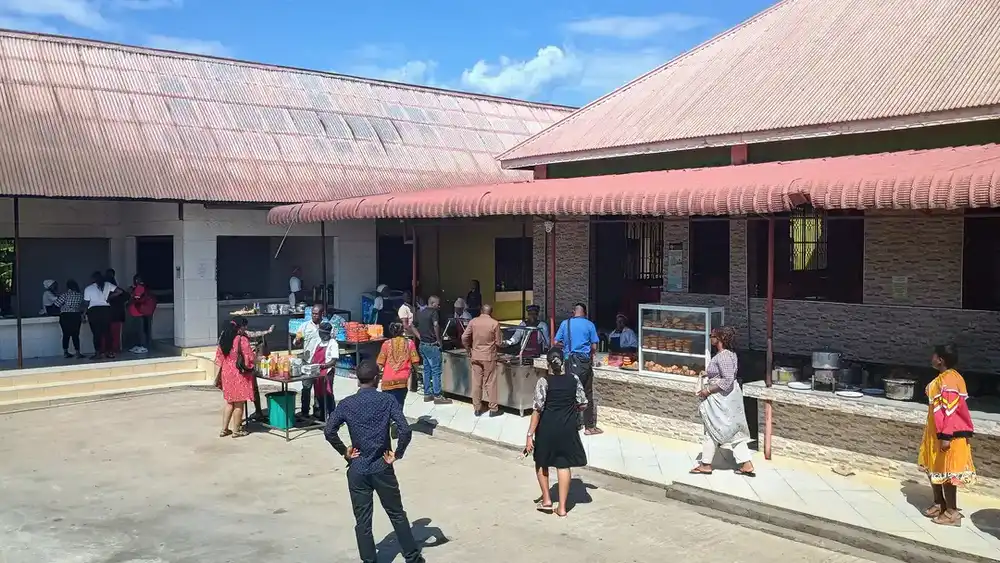
*Photo above: a stop between Arusha and Dodoma.*
I returned to my hostel, packed my bag, and picked up snacks and water from Shoppers Supermarket, knowing that Tanzanian bus rides tend to take longer than expected. The 80-kilometer journey from Moshi to Arusha had taken me up to three hours, so I expected the longer trip to Dodoma to stretch beyond the promised eight hours.
## The Journey to Dodoma
The bus ride was predictably long, making frequent stops along the way. Upon arrival in Dodoma, the bus meandered through the city, dropping off passengers. My booked accommodation was just under two kilometers from the final stop, so I decided to walk, relying on Google Maps to guide me.
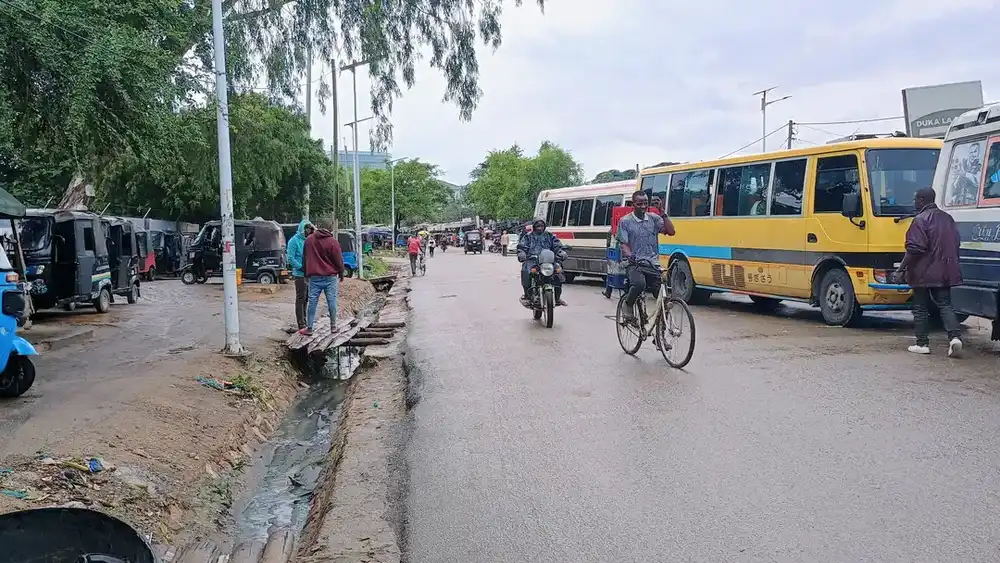
*Photo above: in Dodoma.*
When I arrived at what was supposed to be my lodging, I was skeptical. The house lacked a sign, and an elderly woman was doing laundry in the yard. When I asked if this was the right place, she called a younger woman who spoke English and welcomed me inside. The accommodation was a full apartment, complete with a kitchen, but not cheap. Later in the evening, I attempted to shower, only to discover there was no running water. I resorted to a bucket shower, but the cramped bathroom caused water to spill into the apartment.
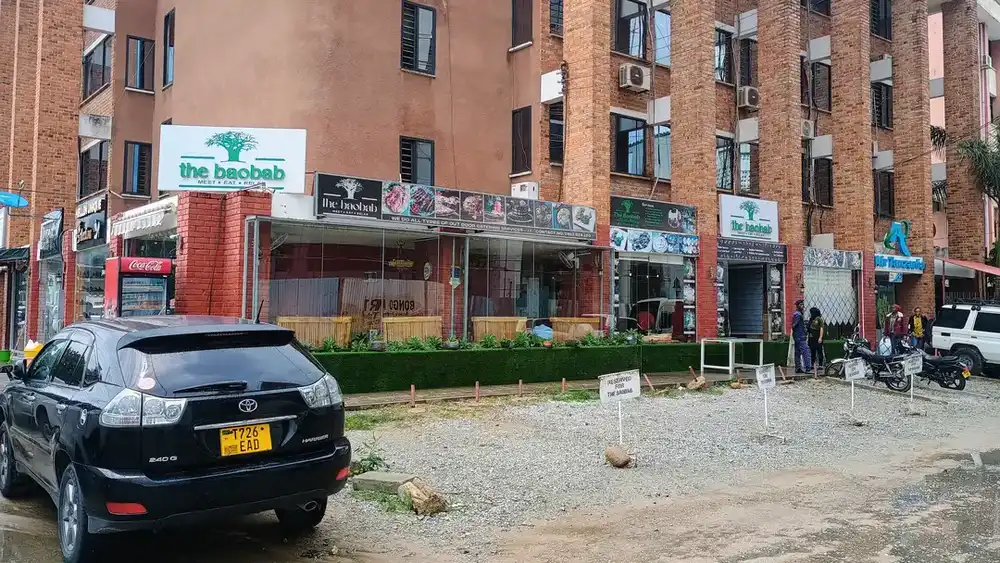
*Photo above: the Baobab Café in Dodoma.*
## Exploring Dodoma
The next day, I set out to explore Dodoma. I passed a cozy café and an old-looking church, which I later learned was not as ancient as it seemed. Strolling down a lively shopping district, I admired the small stores lining the streets. Eventually, I settled at the café I had spotted earlier, enjoying a simple dinner of bread and tomato salad.
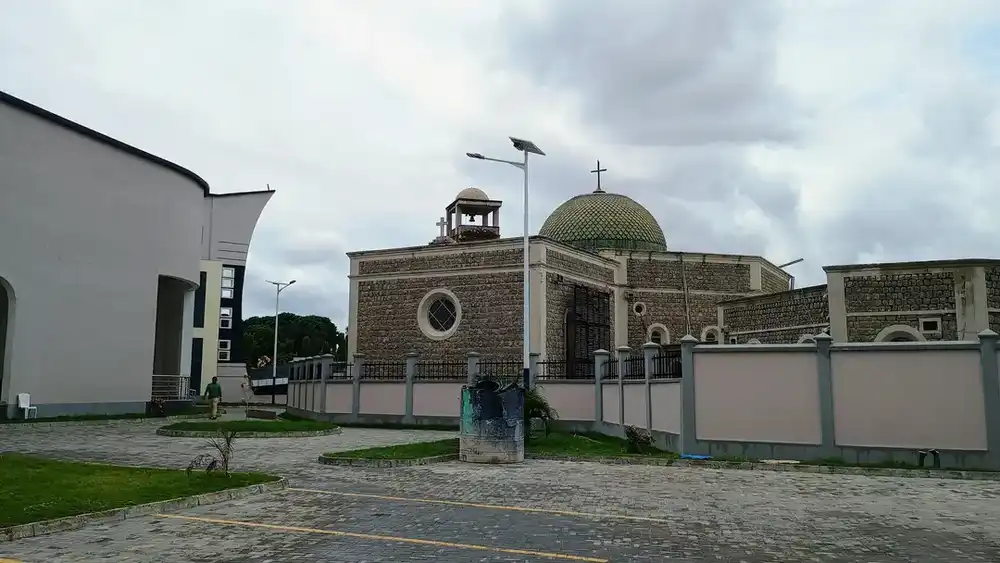
*Photo above: the church in Dodoma.*
Originally, I had planned to stay for just one night, but the city intrigued me, and I extended my stay. This meant I had to book my next bus ticket and gather supplies. Using the Bolt app, I ordered a TukTuk to take me to the Shabiby bus terminal. The ride cost 2,000 TZS — without Bolt, I would have been charged significantly more. I bought my ticket to Mbeya for 40,000 TZS, with a departure time of 5:30 A.M.
That night, I packed my bags and went to bed early, knowing I had an early start ahead.
## The Departure to Mbeya
Waking up at 3:30 A.M., I hurriedly took another bucket shower — still no running water. I initially planned to order a TukTuk, but the Bolt app showed no available drivers. With the bus station only a 13-minute walk away, I set out on foot. Along the way, I stepped into a water hole, soaking myself up to my knees. Street vendors persistently offered me motorcycle rides, but I ignored them and continued walking.
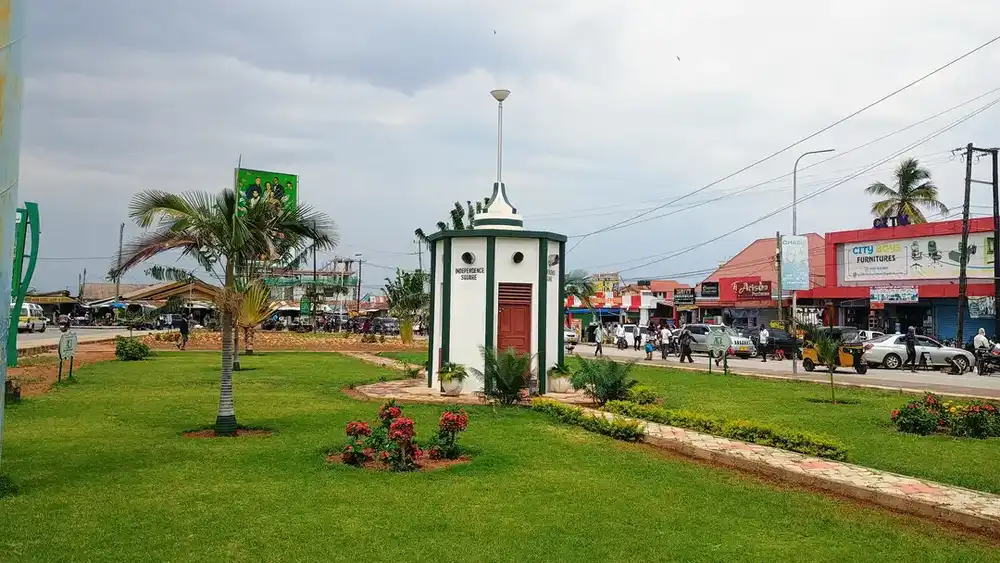
*Photo above: in Dodoma.*
Arriving at the bus station, I saw the previous bus to Mbeya departing. My gut told me something was wrong. Sure enough, my bus was delayed by almost an hour. Finally, it arrived, and I boarded, relieved that I hadn’t missed it after all.
## A Long Ride to Mbeya
The previous day, I had suffered from severe diarrhea. Fortunately, a local pharmacy in Dodoma provided me with pills that helped stabilize my system. I also continued taking my daily dose of Doxycycline as a malaria precaution.
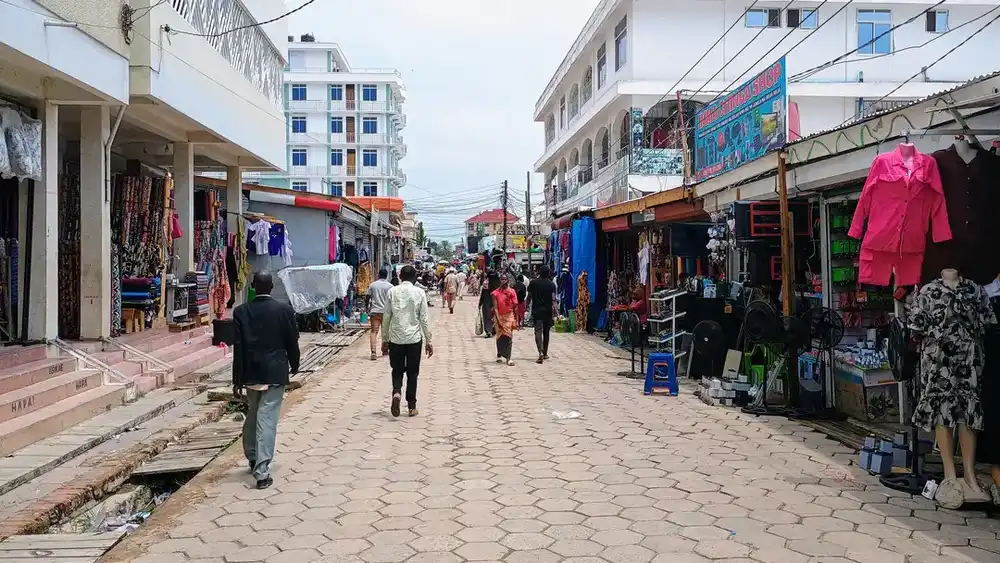
*Photo above: shopping street in Dodoma.*
This time, I had a window seat with no one beside me, allowing me to place my backpack on the empty seat. As we traveled, I watched the Tanzanian landscape unfold. At one point, the bus crossed a dam, likely a reservoir, before being stopped by police. A policeman entered, checked my passport, and inquired about my destination. When I mentioned Mbeya, he ask me where after, and I told him to Lusaka. Then he asked if it was in Zambia, returned my passport, and he let us continue.
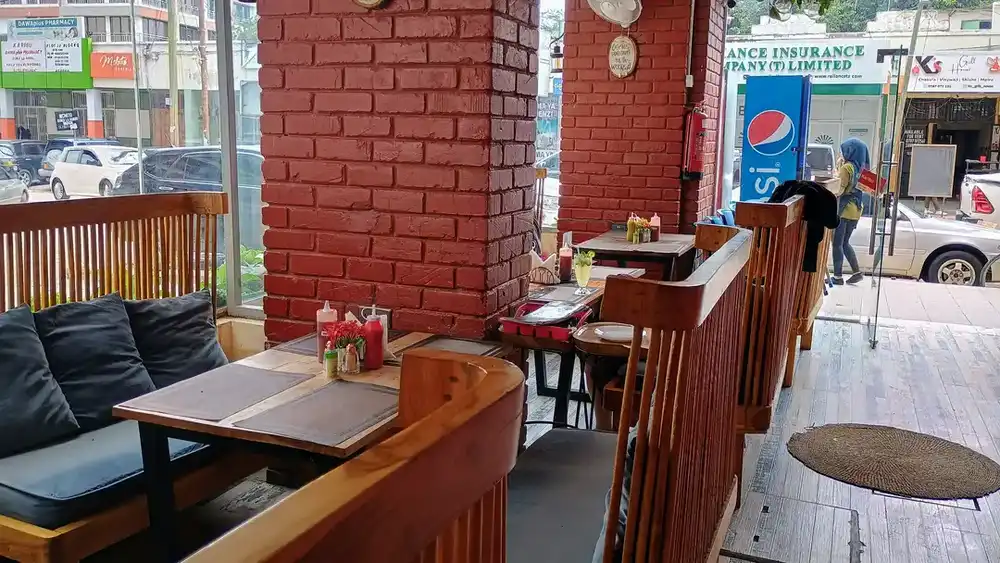
*Photo above: the Baobab Café in Dodoma.*
My host in Mbeya had instructed me to get off at Nane Nane Stand. Upon arrival, I searched for a TukTuk. Without internet access, I had to negotiate fares blindly. After rejecting overpriced offers, I managed to bargain a price of 5,000 TZS for the short ride to my accommodation, what was a bit high for a Tuktuk.
## Mbeya and the Journey to the Border
Initially planning to stay two nights, exhaustion led me to extend for an extra night. The hostel was beautiful and clean but, yet again, had no running water. However, this time, the host kindly boiled water for me, allowing me to take a warm bucket shower.
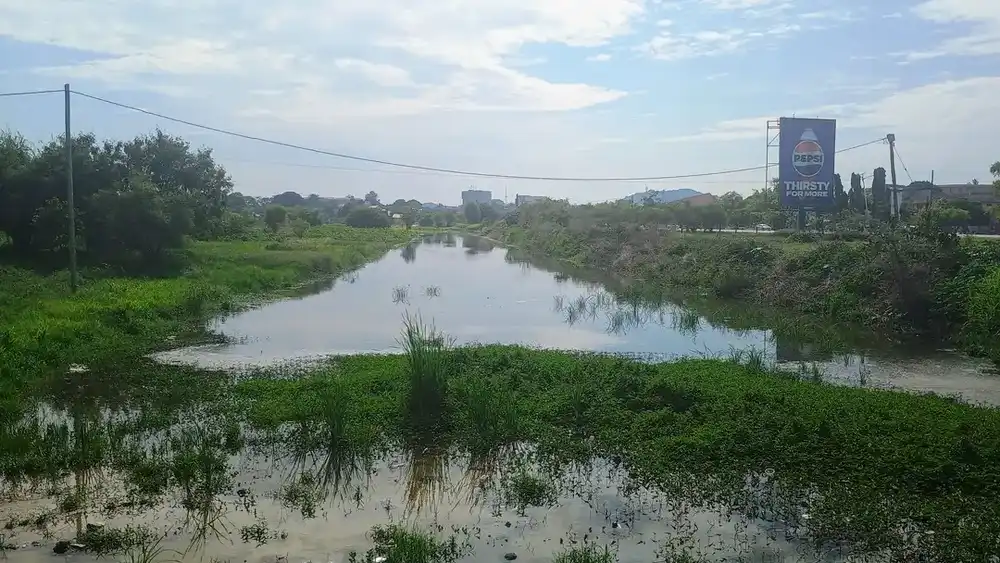
*Photo above: on the way to the Supermarket in Dodoma.*
On my final day in Mbeya, I explored the city, visiting a new children's hospital and an old church. Tuktuk drivers repeatedly tried to overcharge me, but I insisted on the standard 800 TZS fare for public transport.
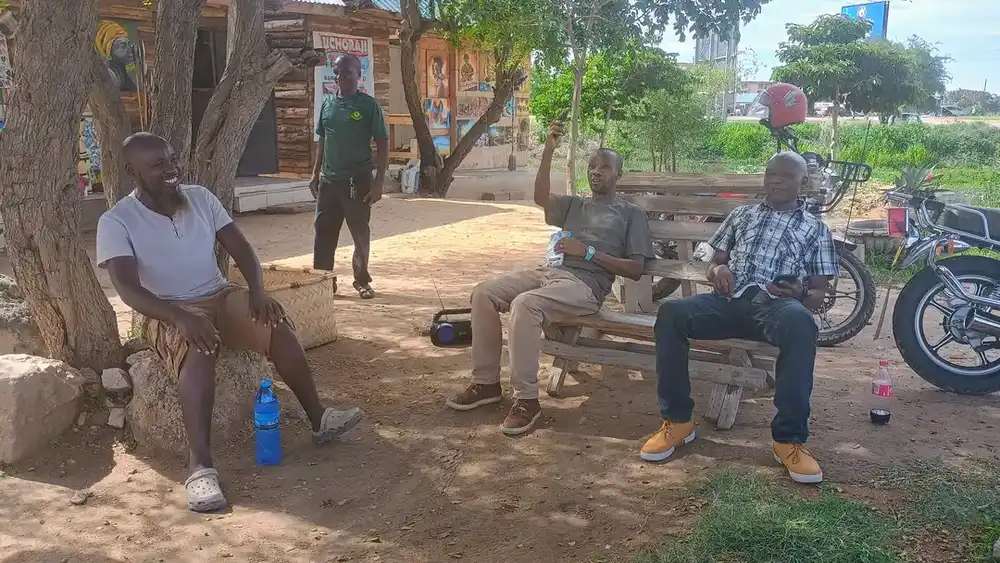
*Photo above: on the way to the Supermarket in Dodoma.*
The following morning, after a quick breakfast, I set off for the bus station with a fellow traveler I met at the hostel. Together, we took a bus to Tunduma for 5,000 TZS each. From there, a TukTuk ride to the border cost another 5,000 TZS.
## Crossing into Zambia
The border crossing was straightforward for me — I received a free 30-day visa for Zambia. My Russian travel companion, however, needed a visa on arrival, payable in cash and only in USD. The immigration officer arranged a taxi to take us to an ATM, but the only available bank, Absa, charged exorbitant fees. Fortunately, we later found a Zanaco ATM in Nakonde that had no fees.
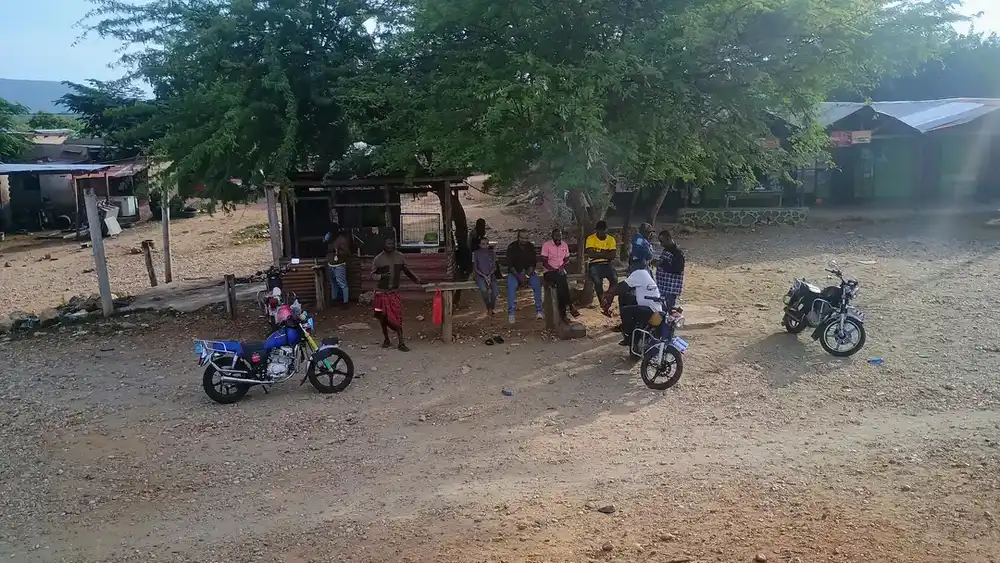
*Photo above: between Dodoma and Mbeya.*
Once we had the necessary cash, we returned to the Border immigration, paid for the visa, and proceeded into Zambia. We walked to town, grabbed some food, and checked into Shalom Hotel. It was cheap, costing only 200 Kwacha per night (under 10 Euros), but lacked cleanliness and had no running water.
## A Frustrating Bus Experience
We booked a 4 A.M. bus to Lusaka with Jkas, supposedly the best company. However, when we arrived at the station at 3:28 A.M., the bus was already gone. The staff had lied, telling us the bus left at 4 A.M. but actually departing at 3 A.M. They then offered an overpriced taxi to chase the bus, which we declined.
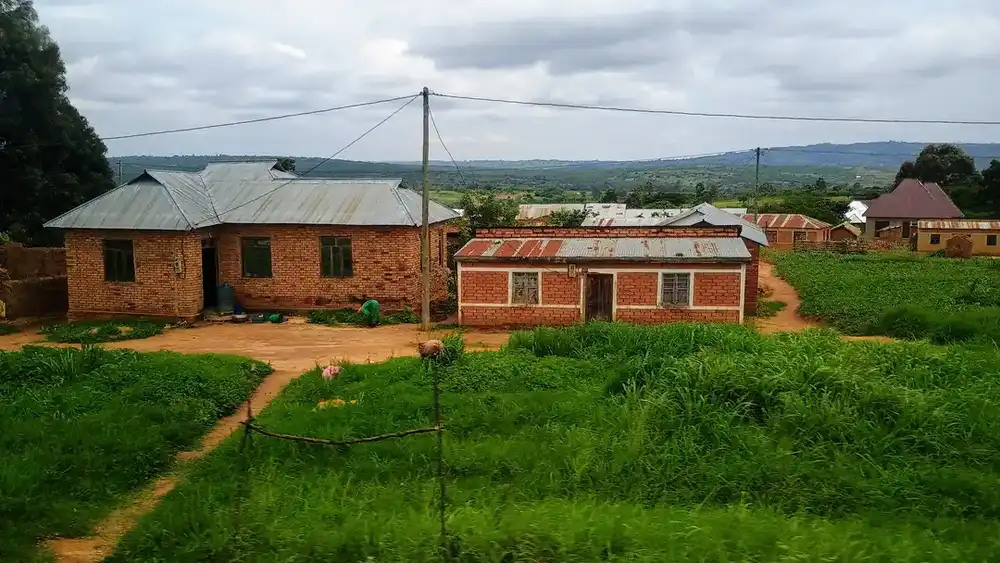
*Photo above: between Dodoma and Mbeya.*
With no other options left, we searched for an alternative and eventually made our way to the PowerTools bus station — only to find that the bus also had already left.
The next bus? **Overnight.**
We were stuck.
### The Boda Chase
That’s when a Boda driver approached us. He had been waiting at the Powertools station, watching the situation unfold. **“I know where your bus is,”** he said. **“At the checkpoint. I can take you.”**
There was no time to think. We climbed on.
The night was pitch black, the streets slick with rain and mud. As soon as he twisted the throttle, the bike lurched forward. The driver wasn’t smooth — he was riding like a madman, shaking left and right as he weaved through the darkness. The wet road made it worse, and the mud felt like a trap waiting to swallow us whole.
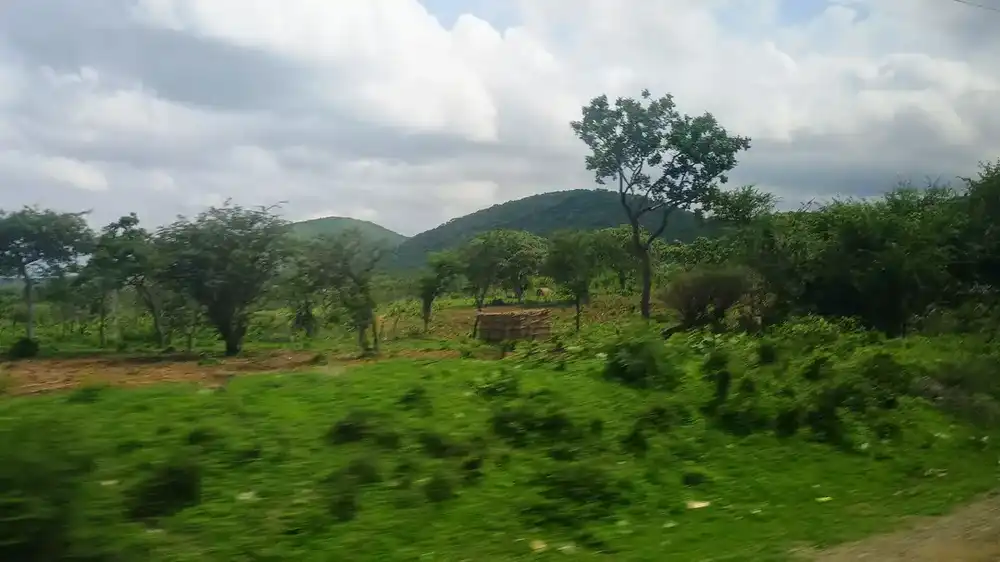
*Photo above: between Dodoma and Mbeya.*
A gust of wind blew my hat into my face, blinding me for the most time. My gut twisted — I could almost see the crash before it happened. **“Slow down!”** I shouted. He eased off for a while, but soon enough, he hit the gas again. **“I said slow down!”** I had to remind him.
It felt like an eternity. The only thought keeping me together was the hope that the checkpoint was close.
Then — buses. Dozens of them.
We told him which one was ours, but in the dim light, they all looked the same. He swerved between them, searching, until finally — **Jkas.**
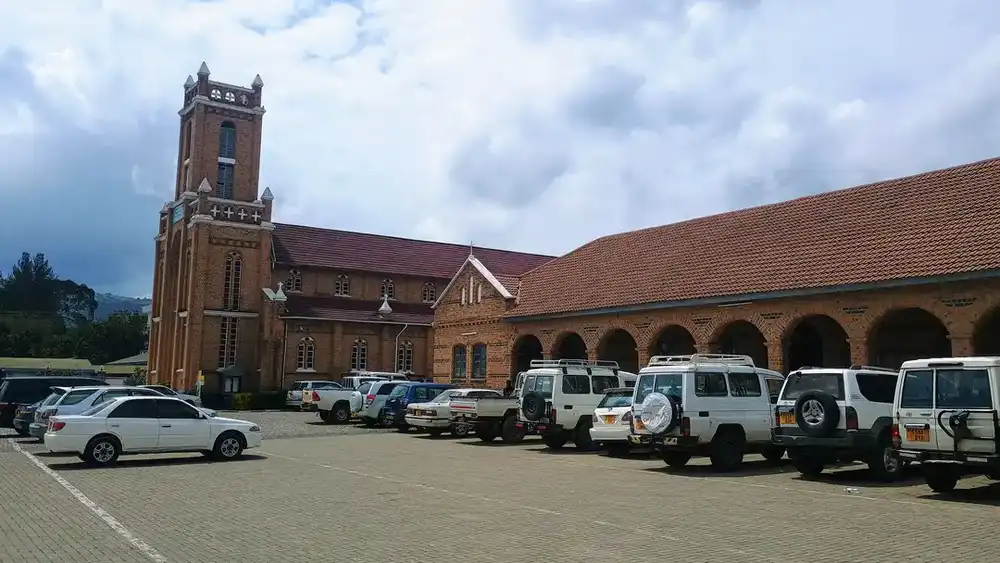
*Photo above: the old church in Mbeya.*
As we pulled up, the driver suddenly changed his price from 200 to 400 Kwacha. Of course. I handed him 300, not in the mood to argue, and walked straight into the bus, **relieved to be off that death ride**.
The journey continued, but the morning’s chaos was a reminder that travel in Africa often requires patience and adaptability.
---
## Final Thoughts
The journey from Arusha to Lusaka was long and filled with challenges — delayed buses, unreliable accommodations, and frustrating border experiences. Yet, the beauty of Tanzania and Zambia, the people I met, and the lessons I learned along the way made it all worthwhile. Traveling in Africa requires flexibility, but it rewards you with unforgettable experiences and stories to tell.
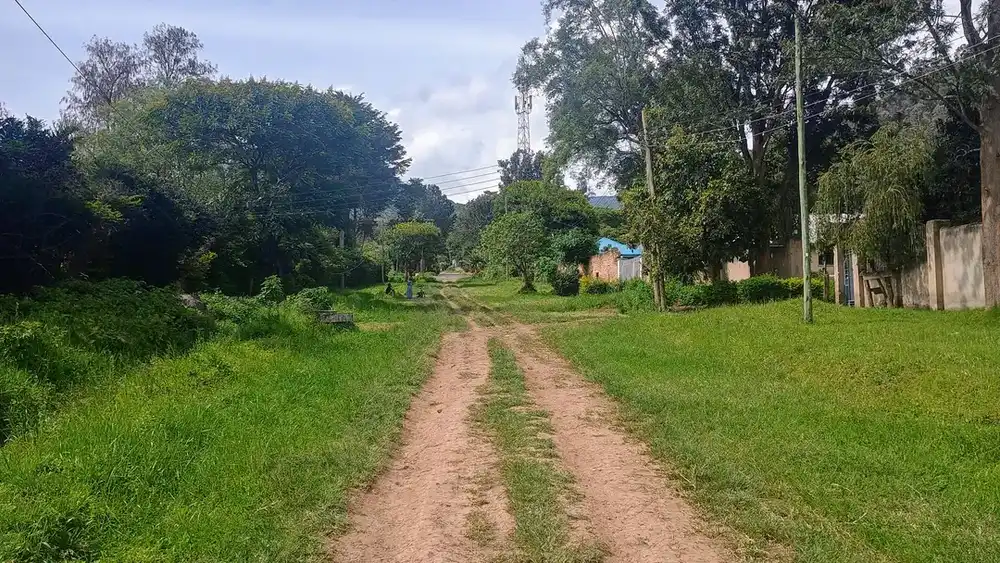
*Photo above: in Mbeya.*
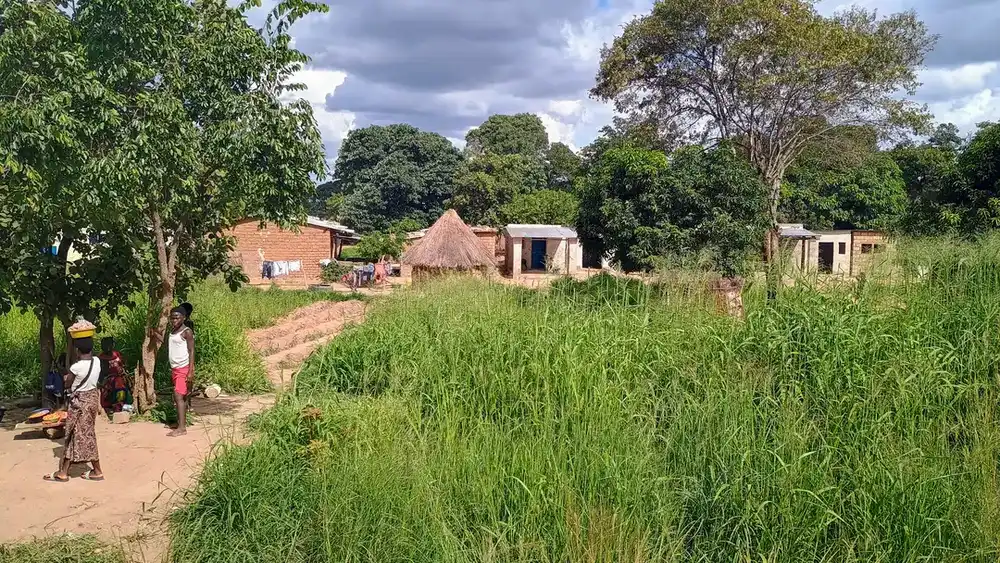
*Photo above: somewhere in Zambia from the Bus.*

*Photo above: in Lusaka.*
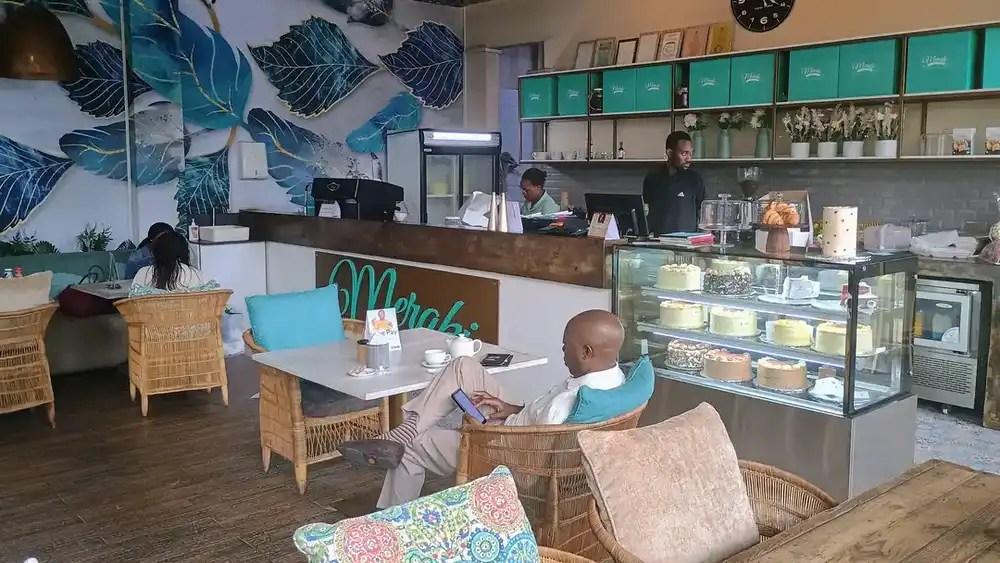
*Photo above: in the East Park Mall in Lusaka.*

*Photo above: in the East Park Mall in Lusaka.*
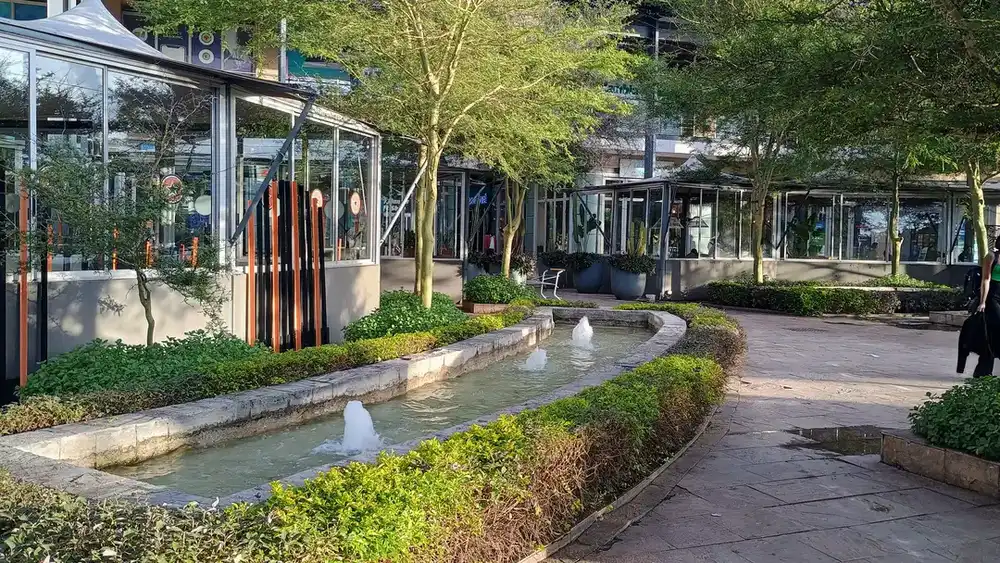
*Photo above: East Park Mall in Lusaka.*
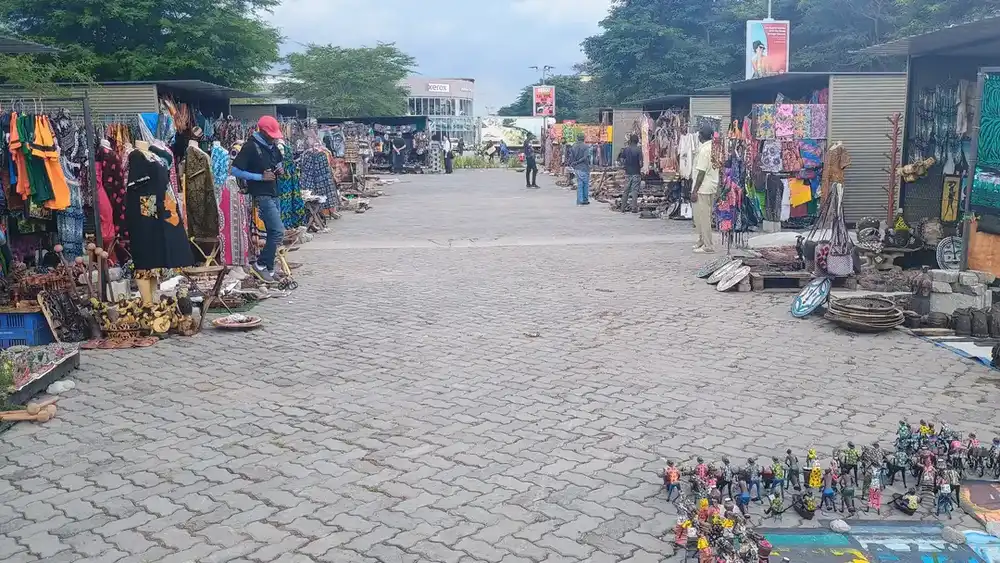
*Photo above: in the market in Lusaka.*
-

@ a012dc82:6458a70d
2025-02-14 13:51:33
In the ever-evolving landscape of cryptocurrency, a significant development has emerged that is reshaping perceptions and strategies within the industry. Bitcoin, the original and most prominent digital currency, has seen its transaction fees hit a two-year high. This remarkable surge in fees is not merely a statistical blip but a phenomenon that could herald a transformative phase in Bitcoin mining. As we witness these fees reaching unprecedented levels, it prompts a crucial inquiry: Are we on the cusp of a new era in BTC mining, one that redefines its economic and technological paradigms?
**Table Of Content**
- The Surge in Transaction Fees
- Impact on Bitcoin Miners
- A Divided Community
- The Ripple Effect on Mining Stocks
- The Broader Market Influence
- Conclusion
- FAQs
**The Surge in Transaction Fees**
The Bitcoin network, known for its robustness and security, has recently been the center of a notable financial trend. Transaction fees have soared to over $37, a figure reminiscent of the peak levels observed in April 2021. This significant increase is not an isolated event but rather a symptom of a larger, more complex shift within the Bitcoin ecosystem. The primary driver behind this surge is the burgeoning interest in Bitcoin NFTs, particularly through a protocol known as Ordinals. This innovative protocol facilitates the storage of non-fungible tokens (NFTs) directly on the Bitcoin blockchain. As a result, there has been a marked increase in transaction volumes, leading to higher fees. This trend reflects a growing interest in utilizing Bitcoin not just as a currency but as a platform for broader digital asset interactions, potentially expanding its use cases and value proposition.
**Impact on Bitcoin Miners**
The escalation in transaction fees has had a profound and far-reaching impact on the community of Bitcoin miners. These individuals and companies, who form the backbone of the Bitcoin network by validating transactions and maintaining the blockchain, are now witnessing a dramatic shift in their revenue streams. With fees reaching such high levels, their daily income has surged to an estimated $63 million, translating to an extraordinary $23 billion annually. This figure is a significant leap from the average income over the past two years and represents a potential windfall for the mining sector. The increased profitability could lead to renewed investment in mining infrastructure, potentially spurring technological advancements and increased competition within the sector. It also raises questions about the decentralization of Bitcoin mining, as higher profits could lead to further consolidation in an industry already dominated by large players.
**A Divided Community**
The Bitcoin community, known for its diverse opinions and robust debates, finds itself at a crossroads with the rise of Ordinals and its impact on transaction fees. On one hand, some members of the community, including prominent figures like core developer Luke Dashjr, view the influx of Ordinals as a form of spam that clutters the blockchain and necessitates technical solutions. This perspective underscores concerns about blockchain bloat, transaction prioritization, and the fundamental principles of what Bitcoin should represent. On the other hand, for miners, these high fees have been a significant boon. They have provided a much-needed boost to profitability, especially in a period where the price of Bitcoin itself has been relatively stable. This divergence in views reflects the ongoing evolution of Bitcoin's identity and purpose, as it balances its role as a digital gold, a transactional currency, and now, a platform for digital art and collectibles.
**The Ripple Effect on Mining Stocks**
The impact of the surge in Bitcoin fees extends beyond the digital realm and into the traditional financial markets. Bitcoin mining stocks, representing companies that invest heavily in the infrastructure required to mine the digital currency, have shown remarkable resilience and growth. Companies like Marathon Digital, Riot Platform, and Cleanspark have seen their stock prices rally, significantly outperforming the actual price of Bitcoin. This trend indicates a growing investor confidence in the mining sector, buoyed by the increased revenue potential from transaction fees. It also suggests a decoupling of sorts, where the mining sector's performance is not solely dependent on the price of Bitcoin but also on other factors like transaction volume and fee structures. This decoupling could attract a new class of investors to the mining stocks, those looking for exposure to the crypto market but with a different risk profile than holding cryptocurrencies directly.
**The Broader Market Influence**
The performance of Bitcoin mining stocks is also intricately linked to the broader equity markets. As observed by Caleb Franzen, founder of Cubic Analytics, the strong performance of equity markets has provided additional momentum to these stocks. This correlation indicates that Bitcoin mining companies are increasingly being viewed through the lens of traditional financial analysis, where market trends and investor sentiment play a crucial role. The implication is significant: as Bitcoin mining firms become more integrated into the broader market, they may also become more susceptible to the same macroeconomic factors that influence traditional stocks. This integration could lead to greater stability in the mining sector but also exposes it to new types of risks, such as regulatory changes or shifts in investor sentiment unrelated to the crypto market.
**Conclusion**
The recent developments in Bitcoin transaction fees, driven by the popularity of Ordinals, have ushered in significant changes in the mining landscape. With increased revenues and a positive impact on mining stocks, it's tempting to proclaim the dawn of a new era in Bitcoin mining. However, the sustainability of this trend and its long-term impact on the Bitcoin ecosystem remain subjects of intense speculation and debate. As the community grapples with these changes, the future of Bitcoin mining continues to be a topic of keen interest. Whether this marks a permanent shift or a temporary phase in the cryptocurrency's evolution, one thing is certain: the world of Bitcoin remains as dynamic and unpredictable as ever.
**FAQs**
**What caused the recent spike in Bitcoin transaction fees?**
The surge in Bitcoin transaction fees to over $37, a two-year high, is primarily attributed to the growing popularity of Bitcoin NFTs, especially through the Ordinals protocol, which allows for the storage of non-fungible tokens on the Bitcoin blockchain.
**How does the increase in transaction fees affect Bitcoin miners?**
Bitcoin miners, who earn BTC for processing transactions, have seen a significant increase in their income due to the higher fees. Their daily revenue has reached approximately $63 million, translating to an estimated $23 billion annually.
**What is the Ordinals protocol, and why is it controversial?**
Ordinals is a protocol that enables the storage of NFTs on the Bitcoin blockchain. It has been controversial within the Bitcoin community, with some viewing it as a beneficial innovation and others as a form of spam that clutters the blockchain.
**Have Bitcoin mining stocks been affected by the increase in fees?**
Yes, Bitcoin mining stocks, such as Marathon Digital, Riot Platform, and Cleanspark, have outperformed the actual price of Bitcoin, indicating growing investor confidence in the mining sector due to increased revenue from transaction fees.
**Is the Bitcoin mining industry becoming more centralized?**
The increase in profitability could lead to further investment in mining infrastructure, potentially leading to more competition but also raising concerns about the centralization of mining power in the hands of large companies.
**That's all for today**
**If you want more, be sure to follow us on:**
**NOSTR: croxroad@getalby.com**
**X: [@croxroadnews.co](https://x.com/croxroadnewsco)**
**Instagram: [@croxroadnews.co](https://www.instagram.com/croxroadnews.co/)**
**Youtube: [@croxroadnews](https://www.youtube.com/@croxroadnews)**
**Store: https://croxroad.store**
**Subscribe to CROX ROAD Bitcoin Only Daily Newsletter**
**https://www.croxroad.co/subscribe**
***DISCLAIMER: None of this is financial advice. This newsletter is strictly educational and is not investment advice or a solicitation to buy or sell any assets or to make any financial decisions. Please be careful and do your own research.***
-

@ 09fbf8f3:fa3d60f0
2025-02-14 13:40:37
> 功能很简单的网站,无广告、无任何付费项目,漫画全部免费。
荤素搭配。
唯一的缺点就是有点慢,看了下网站使用的是cloudflare网站加速,国内效果差了一点,加个🪜就好了。
关键词mycomic
官网:[https://mycomic.com](https://mycomic.com)

-

@ 00000001:b0c77eb9
2025-02-14 12:40:40
مواقع التواصل الإجتماعي العامة هي التي تتحكم بك، تتحكم بك بفرض اجندتها وتجبرك على اتبعها وتحظر وتحذف كل ما يخالفها،
وحرية التعبير تنحصر عليها!
و خوارزمياتها الخبيثة التي تعرض لك مايريدون منك أن تراه وتحجب ما لا يريدونك أن تراه.
في نوستر انت المتحكم، انت الذي تحدد من تتابع و انت الذي تحدد المرحلات التي تنشر منشوراتك بها.
نوستر لامركزي، بمعنى عدم وجود سلطة تتحكم ببياناتك، بياناتك موجودة في المرحلات، ولا احد يستطيع حذفها او تعديلها او حظر ظهورها.
و هذا لا ينطبق فقط على مواقع التواصل الإجتماعي العامة، بل ينطبق أيضاً على الـfediverse، في الـfediverse انت لست حر، انت
تتبع الخادم الذي تستخدمه ويستطيع هذا الخادم حظر ما لا يريد ظهوره لك، لأنك لا تتواصل مع بقية الخوادم بنفسك، بل خادمك من
يقوم بذلك بالنيابة عنك.
وحتى إذا كنت تمتلك خادم في شبكة الـfediverse، إذا خالفت اجندة بقية الخوادم ونظرتهم عن حرية الرأي و التعبير سوف يندرج
خادمك في القائمة السوداء fediblock ولن يتمكن خادمك من التواصل مع بقية خوادم الشبكة، ستكون محصور بالخوادم المحظورة،
بالتالي انت في الشبكة الأخرى من الـfediverse!
نعم، يوجد شبكتين في الكون الفدرالي fediverse شبكة الصالحين التابعين للأجندة الغربية وشبكة الطالحين الذين لا يتبعون لها،
إذا تم إدراج خادمك في قائمة fediblock سوف تذهب للشبكة الأخرى!
-

@ bd32f268:22b33966
2025-02-14 12:10:11
Muitos livros foram escritos sobre o tema oferecendo perspetivas líricas, narrativas, psicológicas/filosóficas, religiosas, simbólicas e políticas. A resposta varia no seu significado consoante o paradigma teórico de análise. Reconhecendo esta multiplicidade de dimensões do conceito qualquer reflexão será sempre, inevitavelmente parcial, no entanto cumpre realizar-se dado que a importância do tema o exige. Muito se tem dito e muito mais se dirá precisamente porque este é um tema que convida à expressão de uma profunda intimidade universal.
O amor é, segundo Erich Fromm psicanalista alemão, uma decisão, um julgamento e uma promessa, além de um sentimento. Segundo o autor o amor requer paciência, disciplina, concentração, fé e, quanto a mim uma ideia fundamental de Fromm, a capacidade para transcender o nosso próximo narcisismo. Como seriamos capazes de amar sem ultrapassar o nosso narcisismo? Seríamos capazes do compromisso necessário para aceitar o sacrifício de não corresponder aos nossos desejos mais imediatos em prol da construção de um projeto para o futuro com outra pessoa? No nosso narcisismo reside frequentemente o nosso movimento em direção á gratificação imediata e à não aceitação do sacrifício inerente à construção de algo que desejavelmente será maior que nós.
Como nos diz um pergaminho da Psicologia Gestalt, corrente teórica que se dedica ao estudo da forma e da percepção, o todo é maior que a soma das partes. É precisamente neste ponto que está uma das principais forças centrípetas deste conceito, na hipótese de construir algo que melhora a nossa vida que acrescenta em significado, sendo esta a unidade base na qual psicologicamente se medem as coisas e os fenómenos. Fromm propõe ainda que o amor não será apenas a ligação ao objeto amado, mas também uma orientação perante a vida, dizendo: “ o amor é uma atitude, uma orientação de carácter que determina a ligação da pessoa ao mundo como um todo e não apenas a um objeto.” Sendo assim não será suspeito que neste conceito esteja a chave para operar profundas transformações no carácter e na vida dos Humanos, que a somar á construção da relação com o outro têm a construção de uma nova relação com o mundo.
O amor é uma dádiva na qual ao darmos podemos experienciar a nossa riqueza de carácter, a nossa força e o nosso poder. Podemos ver este conceito como um professor que nos ensina sobre a vida e sobre as relações. Ensina-nos humildade na medida em que aceitamos algo maior que nós, ensina disciplina porque requer um foco constante e diria até que nos pode ensinar o significado e peso do conceito de fé. Neste último ponto falo de fé porque o amor contempla a dúvida fundamental da rejeição do sacrifício feito em prol do amor, e a fé transcende essa dificuldade da dúvida. A fé parece salvar-nos da corrosão da dúvida e purificar as intenções da pessoa que ama. Ter fé é mais que desenvolver uma mera expectativa, é a construção da esperança interiormente mesmo que seja na face do improvável ou implausível. Assim sendo, amar parece-se em muito com uma experiência eminentemente religiosa na medida em que sacraliza a experiência da pessoa que ama e a vida, atribuindo contornos de divino e transcendental ao que, aos olhos que quem não ama, pode parecer trivial e normal.
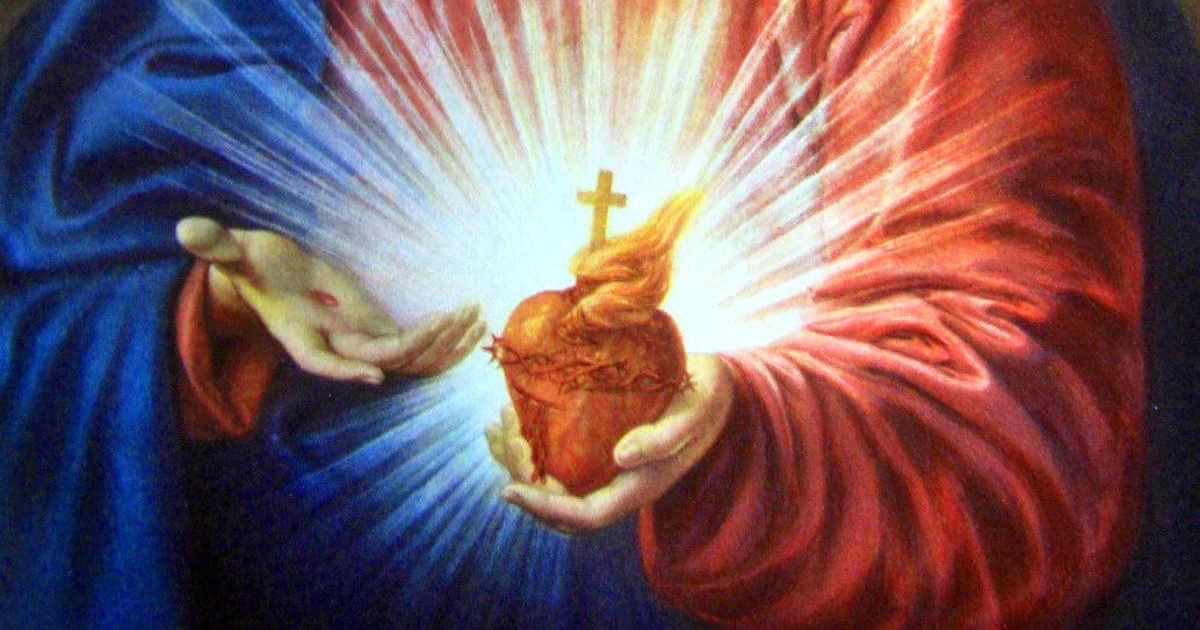*Sagrado coração de Jesus*
Um amor maduro quer-se consciente da necessidade de amar. Fromm diz-nos que o amor maduro está em: “eu preciso de ti porque te amo” e não em “eu amo-te porque preciso de ti”. Esta inversão do sentido da frase parece fundamental para que o amor não seja confundido com uma forma de egoísmo. Aqui a necessidade do outro surge em função do amor que temos pelo outro, não sendo o amor consequência da necessidade que temos do outro. Amar maduramente é a aceitação do sacrifício diante da incerteza e da dor por vezes debilitante. Assim desenvolvemos a tolerância que nos permite crescer e desenraizar da perversidade do narcisismo cumprindo a nossa identidade na missão de amar.

 @ 9e69e420:d12360c2
2025-02-14 18:07:10Vice President J.D. Vance addressed the Munich Security Conference, criticizing European leaders for undermining free speech and traditional values. He claimed that the biggest threat to Europe is not from external enemies but from internal challenges. Vance condemned the arrest of a British man for praying near an abortion clinic and accused European politicians of censorship. He urged leaders to combat illegal immigration and questioned their democratic practices. “There is a new sheriff in town,” he said, referring to President Trump. Vance's remarks were unexpected, as many anticipated discussions on security or Ukraine. His speech emphasized the need for Europe to share the defense burden to ensure stability and security.
@ 9e69e420:d12360c2
2025-02-14 18:07:10Vice President J.D. Vance addressed the Munich Security Conference, criticizing European leaders for undermining free speech and traditional values. He claimed that the biggest threat to Europe is not from external enemies but from internal challenges. Vance condemned the arrest of a British man for praying near an abortion clinic and accused European politicians of censorship. He urged leaders to combat illegal immigration and questioned their democratic practices. “There is a new sheriff in town,” he said, referring to President Trump. Vance's remarks were unexpected, as many anticipated discussions on security or Ukraine. His speech emphasized the need for Europe to share the defense burden to ensure stability and security. @ c43d6de3:a6583169
2025-02-14 17:34:05“IN THIS SPRING of 1953 the free world weighs one question above all others: the chance for a just peace for all peoples,” Dwight D. Eisenhower’s throat went dry and he swallowed to alleviate the burn. Eight years had passed since the end of world war 2 but still the beaches of the Marshall Islands lay charred, Hiroshima and Nagasaki dosed in radiation and ruin, and countless ghost towns still littered Europe’s mangled face. Dwight peered through his glasses at his speech on the podium, then raised his gaze back at the small crowd gathered in front of him in the conference room at the American Society of Newspaper Editors in Washington, D.C. Everyone was on the edge of their seats. The President spoke of peace, but the United States faced a great enemy in the Soviet Union. How would he continue?  “To weigh this chance is to summon instantly to mind another recent moment of great decision. It came with that yet more hopeful spring of 1945, bright with the promise of victory and of freedom. The hope of all just men in that moment too was a just and lasting peace.” The heads among the spectators raised in hope, as if the enthusiasm in the President’s voice could be enough to wipe away any prospect of future war against the Soviet threat. “In that spring of victory the soldiers of the Western Allies met the soldiers of Russia in the center of Europe. They were triumphant comrades in arms. Their peoples shared the joyous prospect of building, in honor of their dead, the only fitting monument-an age of just peace. All these war-weary peoples shared too this concrete, decent purpose: to guard vigilantly against the domination ever again of any part of the world by a single, unbridled aggressive power.” “This common purpose lasted an instant and perished. The nations of the world divided to follow two distinct roads.” “The United States and our valued friends, the other free nations, chose one road.” “The leaders of the Soviet Union chose another.” “The way chosen by the United States was plainly marked by a few clear precepts, which govern its conduct in world affairs.” **What came next in Dwight D. Eisenhower’s speech “The Chance for Peace” is the answer to preventing wars between countries** “First: No people on earth can be held, as a people, to be an enemy, for all humanity shares the **common hunger for peace and fellowship and justice.** Second: No nation's security and well-being can be lastingly achieved in isolation but only in **effective cooperation** with fellow nations. Third: **Any nation's right to a form of government and an economic system** of its own choosing **is inalienable**. Fourth: Any nation's attempt to dictate to other nations their form of government **is indefensible**. And fifth: A nation's hope of lasting peace cannot be firmly based upon any race in armaments but rather upon **just relations and honest understanding** with all other nations.”  **I. First Point** When you minimize any nation or country to its most granular piece, the human family, you realize every nation or country is the same. It is a larger body of human families looking to establish peace out of chaos against nature, fellowship with their neighbor to make that peace possible, and justice against affronts to the foundations of the formerly stated peace and fellowship. Without this, what you have is not a nation but rather wilderness.  **II. Second Point** When we enter the world stage and look at the community of nations it is important we understand that no nation can truly expect to uphold Eisenhower’s first point without the ability to cooperate with other nations. There can be a natural disaster that strikes an entire nation and without exterior help, it may be impossible to overcome. Understand, Eisenhower’s second point only serves as an extension of the first point. Humankind's struggle with nature will always exist, but in cooperation with other communities we can overcome hardship against nature and live in better harmony.  **III. Third Point** It cannot be argued that humans, after millenia of having dispersed across the planet, have collected into pockets of communities of which grew and developed with experiences based on the place in the world where they’ve resided. This has birthed cultures, religions, and moral codes that serve as the foundation of different branches of philosophy that have borne the fruit of governance. Ultimately, no two communities shares the exact same moral code and thus do not share, and will never share, the exact same understanding of what governance should take place. In this respect, it is an inalienable right of the very people within a community to choose how they govern themselves.  **IV. Fourth Point** In trying to impeded on this third point, we come to Eisenhower’s fourth point which is that no other community has the right to dictate how other nations govern themselves. **V. Final Point** Lastly, war will never lead to peace. Only common understanding of the first four points will ever lead to true peace. A race in armaments, as the cold war proved, only leads to further distrust and the breakdown of all other points among the community of nations on the world stage. All that can be done to expect peace is to take your neighbor as they are. St. Augustine has a famous quote, “Seek not to understand that you may believe, but believe that you may understand.” This is meant to drive home the point of faith in the unbelievable. It is how a religious person can believe in a god that they can not prove exists. Some might say there will never be a world without war. I say we already have the recipe for it. We’ve been given this recipe by many leaders throughout our history. Leader’s who’ve witnessed the darkest depths of human evil and wanted to steer humanity away from it.  ----------- Thank you for reading! If this article resonated with you, let me know with a zap and share it with friends who might find it insightful. Your help sends a strong signal to keep making content like this! Interested in fiction? Follow nostr:npub1j9cmpzhlzeex6y85c2pnt45r5zhxhtx73a2twt77fyjwequ4l4jsp5xd49 for great short stories and serialized fiction. More articles you might like from Beneath The Ink: https://primal.net/e/note1ws4es0gahm502k6qgx64dseqhjqgyzh0q7flzk6glcasqxxye6jqm20fj9 nostr:naddr1qvzqqqr4gupzp3padh3au336rew4pzfx78s050p3dw7pmhurgr2ktdcwwxn9svtfqq25yan2w39rsjj0dqk5ckn52ptxsc3nve8hw0aftmq https://primal.net/e/note158ns7z27r2y664h9lsdqdhsjj2uehrejve2y02lkvz46d8xgxncs8pcj7w nostr:naddr1qvzqqqr4gupzp3padh3au336rew4pzfx78s050p3dw7pmhurgr2ktdcwwxn9svtfqq2kjjzzfpjxvutjg33hjvpcw5cyjezyv9y5k0umm6k https://primal.net/e/note1htkygah99mz8p4png992n0clqa44spatw3uzzcpl94etwh2zr60stklxvw nostr:naddr1qvzqqqr4gupzp3padh3au336rew4pzfx78s050p3dw7pmhurgr2ktdcwwxn9svtfqqa9wefdwfjj6stvdsk57cnnv4ehxety94mkjarg94g8ymm8wfjhxuedg9hxgt2fw3ej6sm0wd6xjmn8946hxtfjvsuhsdnju045ml https://primal.net/e/note1rdanqhdgc7d8sypm459zrt55m0zfaze7u34phkew9nptyr3ghwlqsvtsdx nostr:naddr1qvzqqqr4gupzp3padh3au336rew4pzfx78s050p3dw7pmhurgr2ktdcwwxn9svtfqq2ns3jnfa985c29xp2rs3pexpykz6mjxetxu2g25x6
@ c43d6de3:a6583169
2025-02-14 17:34:05“IN THIS SPRING of 1953 the free world weighs one question above all others: the chance for a just peace for all peoples,” Dwight D. Eisenhower’s throat went dry and he swallowed to alleviate the burn. Eight years had passed since the end of world war 2 but still the beaches of the Marshall Islands lay charred, Hiroshima and Nagasaki dosed in radiation and ruin, and countless ghost towns still littered Europe’s mangled face. Dwight peered through his glasses at his speech on the podium, then raised his gaze back at the small crowd gathered in front of him in the conference room at the American Society of Newspaper Editors in Washington, D.C. Everyone was on the edge of their seats. The President spoke of peace, but the United States faced a great enemy in the Soviet Union. How would he continue?  “To weigh this chance is to summon instantly to mind another recent moment of great decision. It came with that yet more hopeful spring of 1945, bright with the promise of victory and of freedom. The hope of all just men in that moment too was a just and lasting peace.” The heads among the spectators raised in hope, as if the enthusiasm in the President’s voice could be enough to wipe away any prospect of future war against the Soviet threat. “In that spring of victory the soldiers of the Western Allies met the soldiers of Russia in the center of Europe. They were triumphant comrades in arms. Their peoples shared the joyous prospect of building, in honor of their dead, the only fitting monument-an age of just peace. All these war-weary peoples shared too this concrete, decent purpose: to guard vigilantly against the domination ever again of any part of the world by a single, unbridled aggressive power.” “This common purpose lasted an instant and perished. The nations of the world divided to follow two distinct roads.” “The United States and our valued friends, the other free nations, chose one road.” “The leaders of the Soviet Union chose another.” “The way chosen by the United States was plainly marked by a few clear precepts, which govern its conduct in world affairs.” **What came next in Dwight D. Eisenhower’s speech “The Chance for Peace” is the answer to preventing wars between countries** “First: No people on earth can be held, as a people, to be an enemy, for all humanity shares the **common hunger for peace and fellowship and justice.** Second: No nation's security and well-being can be lastingly achieved in isolation but only in **effective cooperation** with fellow nations. Third: **Any nation's right to a form of government and an economic system** of its own choosing **is inalienable**. Fourth: Any nation's attempt to dictate to other nations their form of government **is indefensible**. And fifth: A nation's hope of lasting peace cannot be firmly based upon any race in armaments but rather upon **just relations and honest understanding** with all other nations.”  **I. First Point** When you minimize any nation or country to its most granular piece, the human family, you realize every nation or country is the same. It is a larger body of human families looking to establish peace out of chaos against nature, fellowship with their neighbor to make that peace possible, and justice against affronts to the foundations of the formerly stated peace and fellowship. Without this, what you have is not a nation but rather wilderness.  **II. Second Point** When we enter the world stage and look at the community of nations it is important we understand that no nation can truly expect to uphold Eisenhower’s first point without the ability to cooperate with other nations. There can be a natural disaster that strikes an entire nation and without exterior help, it may be impossible to overcome. Understand, Eisenhower’s second point only serves as an extension of the first point. Humankind's struggle with nature will always exist, but in cooperation with other communities we can overcome hardship against nature and live in better harmony.  **III. Third Point** It cannot be argued that humans, after millenia of having dispersed across the planet, have collected into pockets of communities of which grew and developed with experiences based on the place in the world where they’ve resided. This has birthed cultures, religions, and moral codes that serve as the foundation of different branches of philosophy that have borne the fruit of governance. Ultimately, no two communities shares the exact same moral code and thus do not share, and will never share, the exact same understanding of what governance should take place. In this respect, it is an inalienable right of the very people within a community to choose how they govern themselves.  **IV. Fourth Point** In trying to impeded on this third point, we come to Eisenhower’s fourth point which is that no other community has the right to dictate how other nations govern themselves. **V. Final Point** Lastly, war will never lead to peace. Only common understanding of the first four points will ever lead to true peace. A race in armaments, as the cold war proved, only leads to further distrust and the breakdown of all other points among the community of nations on the world stage. All that can be done to expect peace is to take your neighbor as they are. St. Augustine has a famous quote, “Seek not to understand that you may believe, but believe that you may understand.” This is meant to drive home the point of faith in the unbelievable. It is how a religious person can believe in a god that they can not prove exists. Some might say there will never be a world without war. I say we already have the recipe for it. We’ve been given this recipe by many leaders throughout our history. Leader’s who’ve witnessed the darkest depths of human evil and wanted to steer humanity away from it.  ----------- Thank you for reading! If this article resonated with you, let me know with a zap and share it with friends who might find it insightful. Your help sends a strong signal to keep making content like this! Interested in fiction? Follow nostr:npub1j9cmpzhlzeex6y85c2pnt45r5zhxhtx73a2twt77fyjwequ4l4jsp5xd49 for great short stories and serialized fiction. More articles you might like from Beneath The Ink: https://primal.net/e/note1ws4es0gahm502k6qgx64dseqhjqgyzh0q7flzk6glcasqxxye6jqm20fj9 nostr:naddr1qvzqqqr4gupzp3padh3au336rew4pzfx78s050p3dw7pmhurgr2ktdcwwxn9svtfqq25yan2w39rsjj0dqk5ckn52ptxsc3nve8hw0aftmq https://primal.net/e/note158ns7z27r2y664h9lsdqdhsjj2uehrejve2y02lkvz46d8xgxncs8pcj7w nostr:naddr1qvzqqqr4gupzp3padh3au336rew4pzfx78s050p3dw7pmhurgr2ktdcwwxn9svtfqq2kjjzzfpjxvutjg33hjvpcw5cyjezyv9y5k0umm6k https://primal.net/e/note1htkygah99mz8p4png992n0clqa44spatw3uzzcpl94etwh2zr60stklxvw nostr:naddr1qvzqqqr4gupzp3padh3au336rew4pzfx78s050p3dw7pmhurgr2ktdcwwxn9svtfqqa9wefdwfjj6stvdsk57cnnv4ehxety94mkjarg94g8ymm8wfjhxuedg9hxgt2fw3ej6sm0wd6xjmn8946hxtfjvsuhsdnju045ml https://primal.net/e/note1rdanqhdgc7d8sypm459zrt55m0zfaze7u34phkew9nptyr3ghwlqsvtsdx nostr:naddr1qvzqqqr4gupzp3padh3au336rew4pzfx78s050p3dw7pmhurgr2ktdcwwxn9svtfqq2ns3jnfa985c29xp2rs3pexpykz6mjxetxu2g25x6 @ dd664d5e:5633d319
2025-02-14 16:56:29Most people only know customer-to-customer (C2C) and business-to-customer (B2C) software and websites. Those are the famous and popular ones, but business-to-business (B2B) is also pretty big. How big? Even something boring and local like [DATEV](https://www.datev.de/web/de/startseite/startseite-n/) has almost 3 million organizations as customers and €1,44 billion in annual revenue. FedEx has €90 billion in annual revenue and everyone who uses it comes into contact with its software. There's a whole chain of software between the sender and receiver of the package, and it all has to work seamlessly. Same with Walmart, Toyota, Dubai Airport, Glencore, Tesla, Edeka, Carrefour, Harvard and University of Texas, Continental, Allianz, Asklepios, etc. That's the sort of software I help build. You've probably never heard of it, but when it doesn't work properly, you'll hear about it on the news.
@ dd664d5e:5633d319
2025-02-14 16:56:29Most people only know customer-to-customer (C2C) and business-to-customer (B2C) software and websites. Those are the famous and popular ones, but business-to-business (B2B) is also pretty big. How big? Even something boring and local like [DATEV](https://www.datev.de/web/de/startseite/startseite-n/) has almost 3 million organizations as customers and €1,44 billion in annual revenue. FedEx has €90 billion in annual revenue and everyone who uses it comes into contact with its software. There's a whole chain of software between the sender and receiver of the package, and it all has to work seamlessly. Same with Walmart, Toyota, Dubai Airport, Glencore, Tesla, Edeka, Carrefour, Harvard and University of Texas, Continental, Allianz, Asklepios, etc. That's the sort of software I help build. You've probably never heard of it, but when it doesn't work properly, you'll hear about it on the news. @ 554ab6fe:c6cbc27e
2025-02-14 16:29:51Bitcoin’s Price and the Power Law: A Reflection of Energy and the Early Stages of Monetary Adoption Introduction Bitcoin’s price trajectory has long puzzled analysts, with its seemingly chaotic booms and busts. However, when examined through the lens of power laws, a pattern emerges—one that is fundamentally tied to Bitcoin’s energy-based production cost. This article argues that Bitcoin’s price has historically followed a power law because its underlying cost structure is dictated by mining, an energy-intensive process. However, this relationship will not persist indefinitely. I propose that as Bitcoin matures into a widely adopted monetary system, its price will decouple from mining production costs and instead oscillate in accordance with natural business cycles, much like traditional forms of money. **Bitcoin’s Price and the Power Law** Source and Credit: Giovanni Santostasi’s “[The Bitcoin Power Law](https://giovannisantostasi.medium.com/the-bitcoin-power-law-theory-962dfaf99ee9)” When Bitcoin’s price is plotted on a logarithmic scale against time, a strikingly straight-line trajectory appears, punctuated by cycles of rapid price expansion (bull markets) followed by severe corrections (bear markets). These perturbations correspond to Bitcoin’s well-known halving cycles, which occur approximately every four years and reduce the block reward paid to miners, effectively doubling the cost of production per Bitcoin. Historically, Bitcoin’s price has always returned to a fundamental minimum—one that closely aligns with the average cost of mining. This observation suggests that Bitcoin’s power law price behavior is not arbitrary but rather a reflection of its fundamental energy constraints. As in many natural systems governed by power laws, energy dynamics play a central role. In Bitcoin’s case, the “base layer” of its valuation is determined by the energy and computational resources required for mining. This power law behavior is therefore a consequence of Bitcoin’s fundamental design: as block subsidies decrease and mining efficiency improves, the minimum sustainable price follows an upward trajectory dictated by production costs. **Bitcoin as an Energy-Based System** Power laws commonly emerge in natural systems involving energy constraints, from thermodynamics to biological ecosystems and planetary dynamics. Bitcoin, as an energy-based monetary system, exhibits similar characteristics. Mining requires significant electricity and computational power, and as the difficulty adjustment ensures a competitive equilibrium, the cost of mining a Bitcoin remains closely tied to its market value over the long run. Unlike traditional fiat currencies, which are controlled by central banks and subject to arbitrary monetary expansion, Bitcoin’s supply schedule is immutable. Its economic foundation is rooted in **proof of work**, where value is derived from energy expenditure. This fundamental linkage between energy and price explains why Bitcoin’s valuation has adhered to a power law trajectory. It is an entropy engine, and follows physical laws related to energy and entropy. However, this pattern is not a permanent feature of Bitcoin’s monetary future—it is, rather, an indication of Bitcoin’s **early-stage monetization process**. **The Transition from Mining-Based Pricing to a Business Cycle** A crucial implication of Bitcoin’s price following a power law dictated by mining costs is that it suggests Bitcoin has yet to fully mature as money. If Bitcoin were already a widely adopted monetary standard, its valuation would no longer be primarily influenced by the floor mining costs but instead by macroeconomic forces—specifically, the natural fluctuations of the business cycle. In a world where Bitcoin is the dominant global currency, the “price of money” (which correlates with the cost of capital and prevailing interest rates) would fluctuate according to the broader economic cycle. The dynamics would resemble those of natural interest rate cycles described by the Austrian School of Economics: - During periods of economic expansion, lower interest rates spur increased investment and consumption, prices slightly rise, and savings deplete. - As savings decline and prices rise, interest rates naturally rise as well, leading to reduced investment and spending, initiating a contractionary phase and lowered prices. - During the contraction, savings accumulate, more capital becomes available, and interest rates and prices decline. - With the availability of capital, lower interest rates and lowered prices, the economy is now ready to enter a phase of investment and expansion once again. - This oscillatory process continues indefinitely, driven by real economic growth rather than central bank intervention. If Bitcoin were fully monetized, its price would no longer oscillate based on mining halvings and energy costs but instead reflect **economic expansion and contraction cycles**—just as traditional currencies do when not artificially manipulated by central banks. **The Early Stage Indicator: Bitcoin’s Dependence on Mining Costs** Today, Bitcoin’s price still “bounces” off the power law baseline, indicating that its valuation remains primarily anchored to its minimum cost of production. This means that, while Bitcoin is widely recognized as an asset, it has not yet reached the level of adoption where its price is dictated by macroeconomic cycles. A future in which Bitcoin is used as a primary medium of exchange and unit of account would necessarily imply a **decoupling from mining-driven pricing**. Instead of periodic halvings triggering speculative bull runs followed by crashes, Bitcoin’s price would become far more stable, with fluctuations primarily driven by business cycle dynamics. The continued adherence to the power law model, therefore, is evidence that Bitcoin is still in an early phase of adoption—where mining remains a primary determinant of price. **Conclusion** Bitcoin’s price trajectory has long conformed to a power law, reflecting the underlying energy costs of mining. This characteristic, however, is likely not a permanent feature but rather a hallmark of Bitcoin’s early stage as an emerging monetary system. As adoption increases and Bitcoin becomes widely used as money, its price should transition away from being dictated by mining costs and should instead fluctuate according to the natural oscillations of the business cycle. The persistence of Bitcoin’s power law trend is a sign that it remains in its infancy. The real transformation will occur when Bitcoin is no longer bound to its production cost but is instead driven by the natural ebb and flow of savings, investment, and capital cycles—marking its full emergence as a global monetary system. Disclaimer: The information provided in this blog is for informational and educational purposes only and should not be construed as financial advice. Please consult with a financial advisor or conduct your own research before making any financial decisions.
@ 554ab6fe:c6cbc27e
2025-02-14 16:29:51Bitcoin’s Price and the Power Law: A Reflection of Energy and the Early Stages of Monetary Adoption Introduction Bitcoin’s price trajectory has long puzzled analysts, with its seemingly chaotic booms and busts. However, when examined through the lens of power laws, a pattern emerges—one that is fundamentally tied to Bitcoin’s energy-based production cost. This article argues that Bitcoin’s price has historically followed a power law because its underlying cost structure is dictated by mining, an energy-intensive process. However, this relationship will not persist indefinitely. I propose that as Bitcoin matures into a widely adopted monetary system, its price will decouple from mining production costs and instead oscillate in accordance with natural business cycles, much like traditional forms of money. **Bitcoin’s Price and the Power Law** Source and Credit: Giovanni Santostasi’s “[The Bitcoin Power Law](https://giovannisantostasi.medium.com/the-bitcoin-power-law-theory-962dfaf99ee9)” When Bitcoin’s price is plotted on a logarithmic scale against time, a strikingly straight-line trajectory appears, punctuated by cycles of rapid price expansion (bull markets) followed by severe corrections (bear markets). These perturbations correspond to Bitcoin’s well-known halving cycles, which occur approximately every four years and reduce the block reward paid to miners, effectively doubling the cost of production per Bitcoin. Historically, Bitcoin’s price has always returned to a fundamental minimum—one that closely aligns with the average cost of mining. This observation suggests that Bitcoin’s power law price behavior is not arbitrary but rather a reflection of its fundamental energy constraints. As in many natural systems governed by power laws, energy dynamics play a central role. In Bitcoin’s case, the “base layer” of its valuation is determined by the energy and computational resources required for mining. This power law behavior is therefore a consequence of Bitcoin’s fundamental design: as block subsidies decrease and mining efficiency improves, the minimum sustainable price follows an upward trajectory dictated by production costs. **Bitcoin as an Energy-Based System** Power laws commonly emerge in natural systems involving energy constraints, from thermodynamics to biological ecosystems and planetary dynamics. Bitcoin, as an energy-based monetary system, exhibits similar characteristics. Mining requires significant electricity and computational power, and as the difficulty adjustment ensures a competitive equilibrium, the cost of mining a Bitcoin remains closely tied to its market value over the long run. Unlike traditional fiat currencies, which are controlled by central banks and subject to arbitrary monetary expansion, Bitcoin’s supply schedule is immutable. Its economic foundation is rooted in **proof of work**, where value is derived from energy expenditure. This fundamental linkage between energy and price explains why Bitcoin’s valuation has adhered to a power law trajectory. It is an entropy engine, and follows physical laws related to energy and entropy. However, this pattern is not a permanent feature of Bitcoin’s monetary future—it is, rather, an indication of Bitcoin’s **early-stage monetization process**. **The Transition from Mining-Based Pricing to a Business Cycle** A crucial implication of Bitcoin’s price following a power law dictated by mining costs is that it suggests Bitcoin has yet to fully mature as money. If Bitcoin were already a widely adopted monetary standard, its valuation would no longer be primarily influenced by the floor mining costs but instead by macroeconomic forces—specifically, the natural fluctuations of the business cycle. In a world where Bitcoin is the dominant global currency, the “price of money” (which correlates with the cost of capital and prevailing interest rates) would fluctuate according to the broader economic cycle. The dynamics would resemble those of natural interest rate cycles described by the Austrian School of Economics: - During periods of economic expansion, lower interest rates spur increased investment and consumption, prices slightly rise, and savings deplete. - As savings decline and prices rise, interest rates naturally rise as well, leading to reduced investment and spending, initiating a contractionary phase and lowered prices. - During the contraction, savings accumulate, more capital becomes available, and interest rates and prices decline. - With the availability of capital, lower interest rates and lowered prices, the economy is now ready to enter a phase of investment and expansion once again. - This oscillatory process continues indefinitely, driven by real economic growth rather than central bank intervention. If Bitcoin were fully monetized, its price would no longer oscillate based on mining halvings and energy costs but instead reflect **economic expansion and contraction cycles**—just as traditional currencies do when not artificially manipulated by central banks. **The Early Stage Indicator: Bitcoin’s Dependence on Mining Costs** Today, Bitcoin’s price still “bounces” off the power law baseline, indicating that its valuation remains primarily anchored to its minimum cost of production. This means that, while Bitcoin is widely recognized as an asset, it has not yet reached the level of adoption where its price is dictated by macroeconomic cycles. A future in which Bitcoin is used as a primary medium of exchange and unit of account would necessarily imply a **decoupling from mining-driven pricing**. Instead of periodic halvings triggering speculative bull runs followed by crashes, Bitcoin’s price would become far more stable, with fluctuations primarily driven by business cycle dynamics. The continued adherence to the power law model, therefore, is evidence that Bitcoin is still in an early phase of adoption—where mining remains a primary determinant of price. **Conclusion** Bitcoin’s price trajectory has long conformed to a power law, reflecting the underlying energy costs of mining. This characteristic, however, is likely not a permanent feature but rather a hallmark of Bitcoin’s early stage as an emerging monetary system. As adoption increases and Bitcoin becomes widely used as money, its price should transition away from being dictated by mining costs and should instead fluctuate according to the natural oscillations of the business cycle. The persistence of Bitcoin’s power law trend is a sign that it remains in its infancy. The real transformation will occur when Bitcoin is no longer bound to its production cost but is instead driven by the natural ebb and flow of savings, investment, and capital cycles—marking its full emergence as a global monetary system. Disclaimer: The information provided in this blog is for informational and educational purposes only and should not be construed as financial advice. Please consult with a financial advisor or conduct your own research before making any financial decisions. @ da0b9bc3:4e30a4a9
2025-02-14 15:21:29It's Finally here Stackers! It's Friday! We're about to kick off our weekends with some feel good tracks. Let's get the party started. Bring me those Feel Good tracks. It is valentine's so let's get all gooey and soft, let's feel good and loved up. If the world was ending, I'd wanna be next to you. https://youtu.be/kPa7bsKwL-c?si=XbAaVfCHLZw6_0n6 Talk Music. Share Tracks. Zap Sats. Let's go! originally posted at https://stacker.news/items/885888
@ da0b9bc3:4e30a4a9
2025-02-14 15:21:29It's Finally here Stackers! It's Friday! We're about to kick off our weekends with some feel good tracks. Let's get the party started. Bring me those Feel Good tracks. It is valentine's so let's get all gooey and soft, let's feel good and loved up. If the world was ending, I'd wanna be next to you. https://youtu.be/kPa7bsKwL-c?si=XbAaVfCHLZw6_0n6 Talk Music. Share Tracks. Zap Sats. Let's go! originally posted at https://stacker.news/items/885888 @ b2caa9b3:9eab0fb5
2025-02-14 13:55:53After spending two weeks in Arusha, it was time to move on. My next stop was Dodoma. I walked to the bus station in the center of Arusha to check ticket prices, but I disliked the chaotic atmosphere — people approached me nonstop, trying to sell me tickets to destinations I had no interest in. Instead, I went to the Shabiby office, a reputed bus company, and secured a ticket for 29,000 TZS. The bus was scheduled to leave at 10 A.M. the next day, giving me time to prepare.  *Photo above: a stop between Arusha and Dodoma.* I returned to my hostel, packed my bag, and picked up snacks and water from Shoppers Supermarket, knowing that Tanzanian bus rides tend to take longer than expected. The 80-kilometer journey from Moshi to Arusha had taken me up to three hours, so I expected the longer trip to Dodoma to stretch beyond the promised eight hours. ## The Journey to Dodoma The bus ride was predictably long, making frequent stops along the way. Upon arrival in Dodoma, the bus meandered through the city, dropping off passengers. My booked accommodation was just under two kilometers from the final stop, so I decided to walk, relying on Google Maps to guide me.  *Photo above: in Dodoma.* When I arrived at what was supposed to be my lodging, I was skeptical. The house lacked a sign, and an elderly woman was doing laundry in the yard. When I asked if this was the right place, she called a younger woman who spoke English and welcomed me inside. The accommodation was a full apartment, complete with a kitchen, but not cheap. Later in the evening, I attempted to shower, only to discover there was no running water. I resorted to a bucket shower, but the cramped bathroom caused water to spill into the apartment.  *Photo above: the Baobab Café in Dodoma.* ## Exploring Dodoma The next day, I set out to explore Dodoma. I passed a cozy café and an old-looking church, which I later learned was not as ancient as it seemed. Strolling down a lively shopping district, I admired the small stores lining the streets. Eventually, I settled at the café I had spotted earlier, enjoying a simple dinner of bread and tomato salad.  *Photo above: the church in Dodoma.* Originally, I had planned to stay for just one night, but the city intrigued me, and I extended my stay. This meant I had to book my next bus ticket and gather supplies. Using the Bolt app, I ordered a TukTuk to take me to the Shabiby bus terminal. The ride cost 2,000 TZS — without Bolt, I would have been charged significantly more. I bought my ticket to Mbeya for 40,000 TZS, with a departure time of 5:30 A.M. That night, I packed my bags and went to bed early, knowing I had an early start ahead. ## The Departure to Mbeya Waking up at 3:30 A.M., I hurriedly took another bucket shower — still no running water. I initially planned to order a TukTuk, but the Bolt app showed no available drivers. With the bus station only a 13-minute walk away, I set out on foot. Along the way, I stepped into a water hole, soaking myself up to my knees. Street vendors persistently offered me motorcycle rides, but I ignored them and continued walking.  *Photo above: in Dodoma.* Arriving at the bus station, I saw the previous bus to Mbeya departing. My gut told me something was wrong. Sure enough, my bus was delayed by almost an hour. Finally, it arrived, and I boarded, relieved that I hadn’t missed it after all. ## A Long Ride to Mbeya The previous day, I had suffered from severe diarrhea. Fortunately, a local pharmacy in Dodoma provided me with pills that helped stabilize my system. I also continued taking my daily dose of Doxycycline as a malaria precaution.  *Photo above: shopping street in Dodoma.* This time, I had a window seat with no one beside me, allowing me to place my backpack on the empty seat. As we traveled, I watched the Tanzanian landscape unfold. At one point, the bus crossed a dam, likely a reservoir, before being stopped by police. A policeman entered, checked my passport, and inquired about my destination. When I mentioned Mbeya, he ask me where after, and I told him to Lusaka. Then he asked if it was in Zambia, returned my passport, and he let us continue.  *Photo above: the Baobab Café in Dodoma.* My host in Mbeya had instructed me to get off at Nane Nane Stand. Upon arrival, I searched for a TukTuk. Without internet access, I had to negotiate fares blindly. After rejecting overpriced offers, I managed to bargain a price of 5,000 TZS for the short ride to my accommodation, what was a bit high for a Tuktuk. ## Mbeya and the Journey to the Border Initially planning to stay two nights, exhaustion led me to extend for an extra night. The hostel was beautiful and clean but, yet again, had no running water. However, this time, the host kindly boiled water for me, allowing me to take a warm bucket shower.  *Photo above: on the way to the Supermarket in Dodoma.* On my final day in Mbeya, I explored the city, visiting a new children's hospital and an old church. Tuktuk drivers repeatedly tried to overcharge me, but I insisted on the standard 800 TZS fare for public transport.  *Photo above: on the way to the Supermarket in Dodoma.* The following morning, after a quick breakfast, I set off for the bus station with a fellow traveler I met at the hostel. Together, we took a bus to Tunduma for 5,000 TZS each. From there, a TukTuk ride to the border cost another 5,000 TZS. ## Crossing into Zambia The border crossing was straightforward for me — I received a free 30-day visa for Zambia. My Russian travel companion, however, needed a visa on arrival, payable in cash and only in USD. The immigration officer arranged a taxi to take us to an ATM, but the only available bank, Absa, charged exorbitant fees. Fortunately, we later found a Zanaco ATM in Nakonde that had no fees.  *Photo above: between Dodoma and Mbeya.* Once we had the necessary cash, we returned to the Border immigration, paid for the visa, and proceeded into Zambia. We walked to town, grabbed some food, and checked into Shalom Hotel. It was cheap, costing only 200 Kwacha per night (under 10 Euros), but lacked cleanliness and had no running water. ## A Frustrating Bus Experience We booked a 4 A.M. bus to Lusaka with Jkas, supposedly the best company. However, when we arrived at the station at 3:28 A.M., the bus was already gone. The staff had lied, telling us the bus left at 4 A.M. but actually departing at 3 A.M. They then offered an overpriced taxi to chase the bus, which we declined.  *Photo above: between Dodoma and Mbeya.* With no other options left, we searched for an alternative and eventually made our way to the PowerTools bus station — only to find that the bus also had already left. The next bus? **Overnight.** We were stuck. ### The Boda Chase That’s when a Boda driver approached us. He had been waiting at the Powertools station, watching the situation unfold. **“I know where your bus is,”** he said. **“At the checkpoint. I can take you.”** There was no time to think. We climbed on. The night was pitch black, the streets slick with rain and mud. As soon as he twisted the throttle, the bike lurched forward. The driver wasn’t smooth — he was riding like a madman, shaking left and right as he weaved through the darkness. The wet road made it worse, and the mud felt like a trap waiting to swallow us whole.  *Photo above: between Dodoma and Mbeya.* A gust of wind blew my hat into my face, blinding me for the most time. My gut twisted — I could almost see the crash before it happened. **“Slow down!”** I shouted. He eased off for a while, but soon enough, he hit the gas again. **“I said slow down!”** I had to remind him. It felt like an eternity. The only thought keeping me together was the hope that the checkpoint was close. Then — buses. Dozens of them. We told him which one was ours, but in the dim light, they all looked the same. He swerved between them, searching, until finally — **Jkas.**  *Photo above: the old church in Mbeya.* As we pulled up, the driver suddenly changed his price from 200 to 400 Kwacha. Of course. I handed him 300, not in the mood to argue, and walked straight into the bus, **relieved to be off that death ride**. The journey continued, but the morning’s chaos was a reminder that travel in Africa often requires patience and adaptability. --- ## Final Thoughts The journey from Arusha to Lusaka was long and filled with challenges — delayed buses, unreliable accommodations, and frustrating border experiences. Yet, the beauty of Tanzania and Zambia, the people I met, and the lessons I learned along the way made it all worthwhile. Traveling in Africa requires flexibility, but it rewards you with unforgettable experiences and stories to tell.  *Photo above: in Mbeya.*  *Photo above: somewhere in Zambia from the Bus.*  *Photo above: in Lusaka.*  *Photo above: in the East Park Mall in Lusaka.*  *Photo above: in the East Park Mall in Lusaka.*  *Photo above: East Park Mall in Lusaka.*  *Photo above: in the market in Lusaka.*
@ b2caa9b3:9eab0fb5
2025-02-14 13:55:53After spending two weeks in Arusha, it was time to move on. My next stop was Dodoma. I walked to the bus station in the center of Arusha to check ticket prices, but I disliked the chaotic atmosphere — people approached me nonstop, trying to sell me tickets to destinations I had no interest in. Instead, I went to the Shabiby office, a reputed bus company, and secured a ticket for 29,000 TZS. The bus was scheduled to leave at 10 A.M. the next day, giving me time to prepare.  *Photo above: a stop between Arusha and Dodoma.* I returned to my hostel, packed my bag, and picked up snacks and water from Shoppers Supermarket, knowing that Tanzanian bus rides tend to take longer than expected. The 80-kilometer journey from Moshi to Arusha had taken me up to three hours, so I expected the longer trip to Dodoma to stretch beyond the promised eight hours. ## The Journey to Dodoma The bus ride was predictably long, making frequent stops along the way. Upon arrival in Dodoma, the bus meandered through the city, dropping off passengers. My booked accommodation was just under two kilometers from the final stop, so I decided to walk, relying on Google Maps to guide me.  *Photo above: in Dodoma.* When I arrived at what was supposed to be my lodging, I was skeptical. The house lacked a sign, and an elderly woman was doing laundry in the yard. When I asked if this was the right place, she called a younger woman who spoke English and welcomed me inside. The accommodation was a full apartment, complete with a kitchen, but not cheap. Later in the evening, I attempted to shower, only to discover there was no running water. I resorted to a bucket shower, but the cramped bathroom caused water to spill into the apartment.  *Photo above: the Baobab Café in Dodoma.* ## Exploring Dodoma The next day, I set out to explore Dodoma. I passed a cozy café and an old-looking church, which I later learned was not as ancient as it seemed. Strolling down a lively shopping district, I admired the small stores lining the streets. Eventually, I settled at the café I had spotted earlier, enjoying a simple dinner of bread and tomato salad.  *Photo above: the church in Dodoma.* Originally, I had planned to stay for just one night, but the city intrigued me, and I extended my stay. This meant I had to book my next bus ticket and gather supplies. Using the Bolt app, I ordered a TukTuk to take me to the Shabiby bus terminal. The ride cost 2,000 TZS — without Bolt, I would have been charged significantly more. I bought my ticket to Mbeya for 40,000 TZS, with a departure time of 5:30 A.M. That night, I packed my bags and went to bed early, knowing I had an early start ahead. ## The Departure to Mbeya Waking up at 3:30 A.M., I hurriedly took another bucket shower — still no running water. I initially planned to order a TukTuk, but the Bolt app showed no available drivers. With the bus station only a 13-minute walk away, I set out on foot. Along the way, I stepped into a water hole, soaking myself up to my knees. Street vendors persistently offered me motorcycle rides, but I ignored them and continued walking.  *Photo above: in Dodoma.* Arriving at the bus station, I saw the previous bus to Mbeya departing. My gut told me something was wrong. Sure enough, my bus was delayed by almost an hour. Finally, it arrived, and I boarded, relieved that I hadn’t missed it after all. ## A Long Ride to Mbeya The previous day, I had suffered from severe diarrhea. Fortunately, a local pharmacy in Dodoma provided me with pills that helped stabilize my system. I also continued taking my daily dose of Doxycycline as a malaria precaution.  *Photo above: shopping street in Dodoma.* This time, I had a window seat with no one beside me, allowing me to place my backpack on the empty seat. As we traveled, I watched the Tanzanian landscape unfold. At one point, the bus crossed a dam, likely a reservoir, before being stopped by police. A policeman entered, checked my passport, and inquired about my destination. When I mentioned Mbeya, he ask me where after, and I told him to Lusaka. Then he asked if it was in Zambia, returned my passport, and he let us continue.  *Photo above: the Baobab Café in Dodoma.* My host in Mbeya had instructed me to get off at Nane Nane Stand. Upon arrival, I searched for a TukTuk. Without internet access, I had to negotiate fares blindly. After rejecting overpriced offers, I managed to bargain a price of 5,000 TZS for the short ride to my accommodation, what was a bit high for a Tuktuk. ## Mbeya and the Journey to the Border Initially planning to stay two nights, exhaustion led me to extend for an extra night. The hostel was beautiful and clean but, yet again, had no running water. However, this time, the host kindly boiled water for me, allowing me to take a warm bucket shower.  *Photo above: on the way to the Supermarket in Dodoma.* On my final day in Mbeya, I explored the city, visiting a new children's hospital and an old church. Tuktuk drivers repeatedly tried to overcharge me, but I insisted on the standard 800 TZS fare for public transport.  *Photo above: on the way to the Supermarket in Dodoma.* The following morning, after a quick breakfast, I set off for the bus station with a fellow traveler I met at the hostel. Together, we took a bus to Tunduma for 5,000 TZS each. From there, a TukTuk ride to the border cost another 5,000 TZS. ## Crossing into Zambia The border crossing was straightforward for me — I received a free 30-day visa for Zambia. My Russian travel companion, however, needed a visa on arrival, payable in cash and only in USD. The immigration officer arranged a taxi to take us to an ATM, but the only available bank, Absa, charged exorbitant fees. Fortunately, we later found a Zanaco ATM in Nakonde that had no fees.  *Photo above: between Dodoma and Mbeya.* Once we had the necessary cash, we returned to the Border immigration, paid for the visa, and proceeded into Zambia. We walked to town, grabbed some food, and checked into Shalom Hotel. It was cheap, costing only 200 Kwacha per night (under 10 Euros), but lacked cleanliness and had no running water. ## A Frustrating Bus Experience We booked a 4 A.M. bus to Lusaka with Jkas, supposedly the best company. However, when we arrived at the station at 3:28 A.M., the bus was already gone. The staff had lied, telling us the bus left at 4 A.M. but actually departing at 3 A.M. They then offered an overpriced taxi to chase the bus, which we declined.  *Photo above: between Dodoma and Mbeya.* With no other options left, we searched for an alternative and eventually made our way to the PowerTools bus station — only to find that the bus also had already left. The next bus? **Overnight.** We were stuck. ### The Boda Chase That’s when a Boda driver approached us. He had been waiting at the Powertools station, watching the situation unfold. **“I know where your bus is,”** he said. **“At the checkpoint. I can take you.”** There was no time to think. We climbed on. The night was pitch black, the streets slick with rain and mud. As soon as he twisted the throttle, the bike lurched forward. The driver wasn’t smooth — he was riding like a madman, shaking left and right as he weaved through the darkness. The wet road made it worse, and the mud felt like a trap waiting to swallow us whole.  *Photo above: between Dodoma and Mbeya.* A gust of wind blew my hat into my face, blinding me for the most time. My gut twisted — I could almost see the crash before it happened. **“Slow down!”** I shouted. He eased off for a while, but soon enough, he hit the gas again. **“I said slow down!”** I had to remind him. It felt like an eternity. The only thought keeping me together was the hope that the checkpoint was close. Then — buses. Dozens of them. We told him which one was ours, but in the dim light, they all looked the same. He swerved between them, searching, until finally — **Jkas.**  *Photo above: the old church in Mbeya.* As we pulled up, the driver suddenly changed his price from 200 to 400 Kwacha. Of course. I handed him 300, not in the mood to argue, and walked straight into the bus, **relieved to be off that death ride**. The journey continued, but the morning’s chaos was a reminder that travel in Africa often requires patience and adaptability. --- ## Final Thoughts The journey from Arusha to Lusaka was long and filled with challenges — delayed buses, unreliable accommodations, and frustrating border experiences. Yet, the beauty of Tanzania and Zambia, the people I met, and the lessons I learned along the way made it all worthwhile. Traveling in Africa requires flexibility, but it rewards you with unforgettable experiences and stories to tell.  *Photo above: in Mbeya.*  *Photo above: somewhere in Zambia from the Bus.*  *Photo above: in Lusaka.*  *Photo above: in the East Park Mall in Lusaka.*  *Photo above: in the East Park Mall in Lusaka.*  *Photo above: East Park Mall in Lusaka.*  *Photo above: in the market in Lusaka.* @ a012dc82:6458a70d
2025-02-14 13:51:33In the ever-evolving landscape of cryptocurrency, a significant development has emerged that is reshaping perceptions and strategies within the industry. Bitcoin, the original and most prominent digital currency, has seen its transaction fees hit a two-year high. This remarkable surge in fees is not merely a statistical blip but a phenomenon that could herald a transformative phase in Bitcoin mining. As we witness these fees reaching unprecedented levels, it prompts a crucial inquiry: Are we on the cusp of a new era in BTC mining, one that redefines its economic and technological paradigms? **Table Of Content** - The Surge in Transaction Fees - Impact on Bitcoin Miners - A Divided Community - The Ripple Effect on Mining Stocks - The Broader Market Influence - Conclusion - FAQs **The Surge in Transaction Fees** The Bitcoin network, known for its robustness and security, has recently been the center of a notable financial trend. Transaction fees have soared to over $37, a figure reminiscent of the peak levels observed in April 2021. This significant increase is not an isolated event but rather a symptom of a larger, more complex shift within the Bitcoin ecosystem. The primary driver behind this surge is the burgeoning interest in Bitcoin NFTs, particularly through a protocol known as Ordinals. This innovative protocol facilitates the storage of non-fungible tokens (NFTs) directly on the Bitcoin blockchain. As a result, there has been a marked increase in transaction volumes, leading to higher fees. This trend reflects a growing interest in utilizing Bitcoin not just as a currency but as a platform for broader digital asset interactions, potentially expanding its use cases and value proposition. **Impact on Bitcoin Miners** The escalation in transaction fees has had a profound and far-reaching impact on the community of Bitcoin miners. These individuals and companies, who form the backbone of the Bitcoin network by validating transactions and maintaining the blockchain, are now witnessing a dramatic shift in their revenue streams. With fees reaching such high levels, their daily income has surged to an estimated $63 million, translating to an extraordinary $23 billion annually. This figure is a significant leap from the average income over the past two years and represents a potential windfall for the mining sector. The increased profitability could lead to renewed investment in mining infrastructure, potentially spurring technological advancements and increased competition within the sector. It also raises questions about the decentralization of Bitcoin mining, as higher profits could lead to further consolidation in an industry already dominated by large players. **A Divided Community** The Bitcoin community, known for its diverse opinions and robust debates, finds itself at a crossroads with the rise of Ordinals and its impact on transaction fees. On one hand, some members of the community, including prominent figures like core developer Luke Dashjr, view the influx of Ordinals as a form of spam that clutters the blockchain and necessitates technical solutions. This perspective underscores concerns about blockchain bloat, transaction prioritization, and the fundamental principles of what Bitcoin should represent. On the other hand, for miners, these high fees have been a significant boon. They have provided a much-needed boost to profitability, especially in a period where the price of Bitcoin itself has been relatively stable. This divergence in views reflects the ongoing evolution of Bitcoin's identity and purpose, as it balances its role as a digital gold, a transactional currency, and now, a platform for digital art and collectibles. **The Ripple Effect on Mining Stocks** The impact of the surge in Bitcoin fees extends beyond the digital realm and into the traditional financial markets. Bitcoin mining stocks, representing companies that invest heavily in the infrastructure required to mine the digital currency, have shown remarkable resilience and growth. Companies like Marathon Digital, Riot Platform, and Cleanspark have seen their stock prices rally, significantly outperforming the actual price of Bitcoin. This trend indicates a growing investor confidence in the mining sector, buoyed by the increased revenue potential from transaction fees. It also suggests a decoupling of sorts, where the mining sector's performance is not solely dependent on the price of Bitcoin but also on other factors like transaction volume and fee structures. This decoupling could attract a new class of investors to the mining stocks, those looking for exposure to the crypto market but with a different risk profile than holding cryptocurrencies directly. **The Broader Market Influence** The performance of Bitcoin mining stocks is also intricately linked to the broader equity markets. As observed by Caleb Franzen, founder of Cubic Analytics, the strong performance of equity markets has provided additional momentum to these stocks. This correlation indicates that Bitcoin mining companies are increasingly being viewed through the lens of traditional financial analysis, where market trends and investor sentiment play a crucial role. The implication is significant: as Bitcoin mining firms become more integrated into the broader market, they may also become more susceptible to the same macroeconomic factors that influence traditional stocks. This integration could lead to greater stability in the mining sector but also exposes it to new types of risks, such as regulatory changes or shifts in investor sentiment unrelated to the crypto market. **Conclusion** The recent developments in Bitcoin transaction fees, driven by the popularity of Ordinals, have ushered in significant changes in the mining landscape. With increased revenues and a positive impact on mining stocks, it's tempting to proclaim the dawn of a new era in Bitcoin mining. However, the sustainability of this trend and its long-term impact on the Bitcoin ecosystem remain subjects of intense speculation and debate. As the community grapples with these changes, the future of Bitcoin mining continues to be a topic of keen interest. Whether this marks a permanent shift or a temporary phase in the cryptocurrency's evolution, one thing is certain: the world of Bitcoin remains as dynamic and unpredictable as ever. **FAQs** **What caused the recent spike in Bitcoin transaction fees?** The surge in Bitcoin transaction fees to over $37, a two-year high, is primarily attributed to the growing popularity of Bitcoin NFTs, especially through the Ordinals protocol, which allows for the storage of non-fungible tokens on the Bitcoin blockchain. **How does the increase in transaction fees affect Bitcoin miners?** Bitcoin miners, who earn BTC for processing transactions, have seen a significant increase in their income due to the higher fees. Their daily revenue has reached approximately $63 million, translating to an estimated $23 billion annually. **What is the Ordinals protocol, and why is it controversial?** Ordinals is a protocol that enables the storage of NFTs on the Bitcoin blockchain. It has been controversial within the Bitcoin community, with some viewing it as a beneficial innovation and others as a form of spam that clutters the blockchain. **Have Bitcoin mining stocks been affected by the increase in fees?** Yes, Bitcoin mining stocks, such as Marathon Digital, Riot Platform, and Cleanspark, have outperformed the actual price of Bitcoin, indicating growing investor confidence in the mining sector due to increased revenue from transaction fees. **Is the Bitcoin mining industry becoming more centralized?** The increase in profitability could lead to further investment in mining infrastructure, potentially leading to more competition but also raising concerns about the centralization of mining power in the hands of large companies. **That's all for today** **If you want more, be sure to follow us on:** **NOSTR: croxroad@getalby.com** **X: [@croxroadnews.co](https://x.com/croxroadnewsco)** **Instagram: [@croxroadnews.co](https://www.instagram.com/croxroadnews.co/)** **Youtube: [@croxroadnews](https://www.youtube.com/@croxroadnews)** **Store: https://croxroad.store** **Subscribe to CROX ROAD Bitcoin Only Daily Newsletter** **https://www.croxroad.co/subscribe** ***DISCLAIMER: None of this is financial advice. This newsletter is strictly educational and is not investment advice or a solicitation to buy or sell any assets or to make any financial decisions. Please be careful and do your own research.***
@ a012dc82:6458a70d
2025-02-14 13:51:33In the ever-evolving landscape of cryptocurrency, a significant development has emerged that is reshaping perceptions and strategies within the industry. Bitcoin, the original and most prominent digital currency, has seen its transaction fees hit a two-year high. This remarkable surge in fees is not merely a statistical blip but a phenomenon that could herald a transformative phase in Bitcoin mining. As we witness these fees reaching unprecedented levels, it prompts a crucial inquiry: Are we on the cusp of a new era in BTC mining, one that redefines its economic and technological paradigms? **Table Of Content** - The Surge in Transaction Fees - Impact on Bitcoin Miners - A Divided Community - The Ripple Effect on Mining Stocks - The Broader Market Influence - Conclusion - FAQs **The Surge in Transaction Fees** The Bitcoin network, known for its robustness and security, has recently been the center of a notable financial trend. Transaction fees have soared to over $37, a figure reminiscent of the peak levels observed in April 2021. This significant increase is not an isolated event but rather a symptom of a larger, more complex shift within the Bitcoin ecosystem. The primary driver behind this surge is the burgeoning interest in Bitcoin NFTs, particularly through a protocol known as Ordinals. This innovative protocol facilitates the storage of non-fungible tokens (NFTs) directly on the Bitcoin blockchain. As a result, there has been a marked increase in transaction volumes, leading to higher fees. This trend reflects a growing interest in utilizing Bitcoin not just as a currency but as a platform for broader digital asset interactions, potentially expanding its use cases and value proposition. **Impact on Bitcoin Miners** The escalation in transaction fees has had a profound and far-reaching impact on the community of Bitcoin miners. These individuals and companies, who form the backbone of the Bitcoin network by validating transactions and maintaining the blockchain, are now witnessing a dramatic shift in their revenue streams. With fees reaching such high levels, their daily income has surged to an estimated $63 million, translating to an extraordinary $23 billion annually. This figure is a significant leap from the average income over the past two years and represents a potential windfall for the mining sector. The increased profitability could lead to renewed investment in mining infrastructure, potentially spurring technological advancements and increased competition within the sector. It also raises questions about the decentralization of Bitcoin mining, as higher profits could lead to further consolidation in an industry already dominated by large players. **A Divided Community** The Bitcoin community, known for its diverse opinions and robust debates, finds itself at a crossroads with the rise of Ordinals and its impact on transaction fees. On one hand, some members of the community, including prominent figures like core developer Luke Dashjr, view the influx of Ordinals as a form of spam that clutters the blockchain and necessitates technical solutions. This perspective underscores concerns about blockchain bloat, transaction prioritization, and the fundamental principles of what Bitcoin should represent. On the other hand, for miners, these high fees have been a significant boon. They have provided a much-needed boost to profitability, especially in a period where the price of Bitcoin itself has been relatively stable. This divergence in views reflects the ongoing evolution of Bitcoin's identity and purpose, as it balances its role as a digital gold, a transactional currency, and now, a platform for digital art and collectibles. **The Ripple Effect on Mining Stocks** The impact of the surge in Bitcoin fees extends beyond the digital realm and into the traditional financial markets. Bitcoin mining stocks, representing companies that invest heavily in the infrastructure required to mine the digital currency, have shown remarkable resilience and growth. Companies like Marathon Digital, Riot Platform, and Cleanspark have seen their stock prices rally, significantly outperforming the actual price of Bitcoin. This trend indicates a growing investor confidence in the mining sector, buoyed by the increased revenue potential from transaction fees. It also suggests a decoupling of sorts, where the mining sector's performance is not solely dependent on the price of Bitcoin but also on other factors like transaction volume and fee structures. This decoupling could attract a new class of investors to the mining stocks, those looking for exposure to the crypto market but with a different risk profile than holding cryptocurrencies directly. **The Broader Market Influence** The performance of Bitcoin mining stocks is also intricately linked to the broader equity markets. As observed by Caleb Franzen, founder of Cubic Analytics, the strong performance of equity markets has provided additional momentum to these stocks. This correlation indicates that Bitcoin mining companies are increasingly being viewed through the lens of traditional financial analysis, where market trends and investor sentiment play a crucial role. The implication is significant: as Bitcoin mining firms become more integrated into the broader market, they may also become more susceptible to the same macroeconomic factors that influence traditional stocks. This integration could lead to greater stability in the mining sector but also exposes it to new types of risks, such as regulatory changes or shifts in investor sentiment unrelated to the crypto market. **Conclusion** The recent developments in Bitcoin transaction fees, driven by the popularity of Ordinals, have ushered in significant changes in the mining landscape. With increased revenues and a positive impact on mining stocks, it's tempting to proclaim the dawn of a new era in Bitcoin mining. However, the sustainability of this trend and its long-term impact on the Bitcoin ecosystem remain subjects of intense speculation and debate. As the community grapples with these changes, the future of Bitcoin mining continues to be a topic of keen interest. Whether this marks a permanent shift or a temporary phase in the cryptocurrency's evolution, one thing is certain: the world of Bitcoin remains as dynamic and unpredictable as ever. **FAQs** **What caused the recent spike in Bitcoin transaction fees?** The surge in Bitcoin transaction fees to over $37, a two-year high, is primarily attributed to the growing popularity of Bitcoin NFTs, especially through the Ordinals protocol, which allows for the storage of non-fungible tokens on the Bitcoin blockchain. **How does the increase in transaction fees affect Bitcoin miners?** Bitcoin miners, who earn BTC for processing transactions, have seen a significant increase in their income due to the higher fees. Their daily revenue has reached approximately $63 million, translating to an estimated $23 billion annually. **What is the Ordinals protocol, and why is it controversial?** Ordinals is a protocol that enables the storage of NFTs on the Bitcoin blockchain. It has been controversial within the Bitcoin community, with some viewing it as a beneficial innovation and others as a form of spam that clutters the blockchain. **Have Bitcoin mining stocks been affected by the increase in fees?** Yes, Bitcoin mining stocks, such as Marathon Digital, Riot Platform, and Cleanspark, have outperformed the actual price of Bitcoin, indicating growing investor confidence in the mining sector due to increased revenue from transaction fees. **Is the Bitcoin mining industry becoming more centralized?** The increase in profitability could lead to further investment in mining infrastructure, potentially leading to more competition but also raising concerns about the centralization of mining power in the hands of large companies. **That's all for today** **If you want more, be sure to follow us on:** **NOSTR: croxroad@getalby.com** **X: [@croxroadnews.co](https://x.com/croxroadnewsco)** **Instagram: [@croxroadnews.co](https://www.instagram.com/croxroadnews.co/)** **Youtube: [@croxroadnews](https://www.youtube.com/@croxroadnews)** **Store: https://croxroad.store** **Subscribe to CROX ROAD Bitcoin Only Daily Newsletter** **https://www.croxroad.co/subscribe** ***DISCLAIMER: None of this is financial advice. This newsletter is strictly educational and is not investment advice or a solicitation to buy or sell any assets or to make any financial decisions. Please be careful and do your own research.*** @ 09fbf8f3:fa3d60f0
2025-02-14 13:40:37> 功能很简单的网站,无广告、无任何付费项目,漫画全部免费。 荤素搭配。 唯一的缺点就是有点慢,看了下网站使用的是cloudflare网站加速,国内效果差了一点,加个🪜就好了。 关键词mycomic 官网:[https://mycomic.com](https://mycomic.com) 
@ 09fbf8f3:fa3d60f0
2025-02-14 13:40:37> 功能很简单的网站,无广告、无任何付费项目,漫画全部免费。 荤素搭配。 唯一的缺点就是有点慢,看了下网站使用的是cloudflare网站加速,国内效果差了一点,加个🪜就好了。 关键词mycomic 官网:[https://mycomic.com](https://mycomic.com)  @ 00000001:b0c77eb9
2025-02-14 12:40:40مواقع التواصل الإجتماعي العامة هي التي تتحكم بك، تتحكم بك بفرض اجندتها وتجبرك على اتبعها وتحظر وتحذف كل ما يخالفها، وحرية التعبير تنحصر عليها! و خوارزمياتها الخبيثة التي تعرض لك مايريدون منك أن تراه وتحجب ما لا يريدونك أن تراه. في نوستر انت المتحكم، انت الذي تحدد من تتابع و انت الذي تحدد المرحلات التي تنشر منشوراتك بها. نوستر لامركزي، بمعنى عدم وجود سلطة تتحكم ببياناتك، بياناتك موجودة في المرحلات، ولا احد يستطيع حذفها او تعديلها او حظر ظهورها. و هذا لا ينطبق فقط على مواقع التواصل الإجتماعي العامة، بل ينطبق أيضاً على الـfediverse، في الـfediverse انت لست حر، انت تتبع الخادم الذي تستخدمه ويستطيع هذا الخادم حظر ما لا يريد ظهوره لك، لأنك لا تتواصل مع بقية الخوادم بنفسك، بل خادمك من يقوم بذلك بالنيابة عنك. وحتى إذا كنت تمتلك خادم في شبكة الـfediverse، إذا خالفت اجندة بقية الخوادم ونظرتهم عن حرية الرأي و التعبير سوف يندرج خادمك في القائمة السوداء fediblock ولن يتمكن خادمك من التواصل مع بقية خوادم الشبكة، ستكون محصور بالخوادم المحظورة، بالتالي انت في الشبكة الأخرى من الـfediverse! نعم، يوجد شبكتين في الكون الفدرالي fediverse شبكة الصالحين التابعين للأجندة الغربية وشبكة الطالحين الذين لا يتبعون لها، إذا تم إدراج خادمك في قائمة fediblock سوف تذهب للشبكة الأخرى!
@ 00000001:b0c77eb9
2025-02-14 12:40:40مواقع التواصل الإجتماعي العامة هي التي تتحكم بك، تتحكم بك بفرض اجندتها وتجبرك على اتبعها وتحظر وتحذف كل ما يخالفها، وحرية التعبير تنحصر عليها! و خوارزمياتها الخبيثة التي تعرض لك مايريدون منك أن تراه وتحجب ما لا يريدونك أن تراه. في نوستر انت المتحكم، انت الذي تحدد من تتابع و انت الذي تحدد المرحلات التي تنشر منشوراتك بها. نوستر لامركزي، بمعنى عدم وجود سلطة تتحكم ببياناتك، بياناتك موجودة في المرحلات، ولا احد يستطيع حذفها او تعديلها او حظر ظهورها. و هذا لا ينطبق فقط على مواقع التواصل الإجتماعي العامة، بل ينطبق أيضاً على الـfediverse، في الـfediverse انت لست حر، انت تتبع الخادم الذي تستخدمه ويستطيع هذا الخادم حظر ما لا يريد ظهوره لك، لأنك لا تتواصل مع بقية الخوادم بنفسك، بل خادمك من يقوم بذلك بالنيابة عنك. وحتى إذا كنت تمتلك خادم في شبكة الـfediverse، إذا خالفت اجندة بقية الخوادم ونظرتهم عن حرية الرأي و التعبير سوف يندرج خادمك في القائمة السوداء fediblock ولن يتمكن خادمك من التواصل مع بقية خوادم الشبكة، ستكون محصور بالخوادم المحظورة، بالتالي انت في الشبكة الأخرى من الـfediverse! نعم، يوجد شبكتين في الكون الفدرالي fediverse شبكة الصالحين التابعين للأجندة الغربية وشبكة الطالحين الذين لا يتبعون لها، إذا تم إدراج خادمك في قائمة fediblock سوف تذهب للشبكة الأخرى! @ bd32f268:22b33966
2025-02-14 12:10:11Muitos livros foram escritos sobre o tema oferecendo perspetivas líricas, narrativas, psicológicas/filosóficas, religiosas, simbólicas e políticas. A resposta varia no seu significado consoante o paradigma teórico de análise. Reconhecendo esta multiplicidade de dimensões do conceito qualquer reflexão será sempre, inevitavelmente parcial, no entanto cumpre realizar-se dado que a importância do tema o exige. Muito se tem dito e muito mais se dirá precisamente porque este é um tema que convida à expressão de uma profunda intimidade universal. O amor é, segundo Erich Fromm psicanalista alemão, uma decisão, um julgamento e uma promessa, além de um sentimento. Segundo o autor o amor requer paciência, disciplina, concentração, fé e, quanto a mim uma ideia fundamental de Fromm, a capacidade para transcender o nosso próximo narcisismo. Como seriamos capazes de amar sem ultrapassar o nosso narcisismo? Seríamos capazes do compromisso necessário para aceitar o sacrifício de não corresponder aos nossos desejos mais imediatos em prol da construção de um projeto para o futuro com outra pessoa? No nosso narcisismo reside frequentemente o nosso movimento em direção á gratificação imediata e à não aceitação do sacrifício inerente à construção de algo que desejavelmente será maior que nós. Como nos diz um pergaminho da Psicologia Gestalt, corrente teórica que se dedica ao estudo da forma e da percepção, o todo é maior que a soma das partes. É precisamente neste ponto que está uma das principais forças centrípetas deste conceito, na hipótese de construir algo que melhora a nossa vida que acrescenta em significado, sendo esta a unidade base na qual psicologicamente se medem as coisas e os fenómenos. Fromm propõe ainda que o amor não será apenas a ligação ao objeto amado, mas também uma orientação perante a vida, dizendo: “ o amor é uma atitude, uma orientação de carácter que determina a ligação da pessoa ao mundo como um todo e não apenas a um objeto.” Sendo assim não será suspeito que neste conceito esteja a chave para operar profundas transformações no carácter e na vida dos Humanos, que a somar á construção da relação com o outro têm a construção de uma nova relação com o mundo. O amor é uma dádiva na qual ao darmos podemos experienciar a nossa riqueza de carácter, a nossa força e o nosso poder. Podemos ver este conceito como um professor que nos ensina sobre a vida e sobre as relações. Ensina-nos humildade na medida em que aceitamos algo maior que nós, ensina disciplina porque requer um foco constante e diria até que nos pode ensinar o significado e peso do conceito de fé. Neste último ponto falo de fé porque o amor contempla a dúvida fundamental da rejeição do sacrifício feito em prol do amor, e a fé transcende essa dificuldade da dúvida. A fé parece salvar-nos da corrosão da dúvida e purificar as intenções da pessoa que ama. Ter fé é mais que desenvolver uma mera expectativa, é a construção da esperança interiormente mesmo que seja na face do improvável ou implausível. Assim sendo, amar parece-se em muito com uma experiência eminentemente religiosa na medida em que sacraliza a experiência da pessoa que ama e a vida, atribuindo contornos de divino e transcendental ao que, aos olhos que quem não ama, pode parecer trivial e normal. *Sagrado coração de Jesus* Um amor maduro quer-se consciente da necessidade de amar. Fromm diz-nos que o amor maduro está em: “eu preciso de ti porque te amo” e não em “eu amo-te porque preciso de ti”. Esta inversão do sentido da frase parece fundamental para que o amor não seja confundido com uma forma de egoísmo. Aqui a necessidade do outro surge em função do amor que temos pelo outro, não sendo o amor consequência da necessidade que temos do outro. Amar maduramente é a aceitação do sacrifício diante da incerteza e da dor por vezes debilitante. Assim desenvolvemos a tolerância que nos permite crescer e desenraizar da perversidade do narcisismo cumprindo a nossa identidade na missão de amar. 
@ bd32f268:22b33966
2025-02-14 12:10:11Muitos livros foram escritos sobre o tema oferecendo perspetivas líricas, narrativas, psicológicas/filosóficas, religiosas, simbólicas e políticas. A resposta varia no seu significado consoante o paradigma teórico de análise. Reconhecendo esta multiplicidade de dimensões do conceito qualquer reflexão será sempre, inevitavelmente parcial, no entanto cumpre realizar-se dado que a importância do tema o exige. Muito se tem dito e muito mais se dirá precisamente porque este é um tema que convida à expressão de uma profunda intimidade universal. O amor é, segundo Erich Fromm psicanalista alemão, uma decisão, um julgamento e uma promessa, além de um sentimento. Segundo o autor o amor requer paciência, disciplina, concentração, fé e, quanto a mim uma ideia fundamental de Fromm, a capacidade para transcender o nosso próximo narcisismo. Como seriamos capazes de amar sem ultrapassar o nosso narcisismo? Seríamos capazes do compromisso necessário para aceitar o sacrifício de não corresponder aos nossos desejos mais imediatos em prol da construção de um projeto para o futuro com outra pessoa? No nosso narcisismo reside frequentemente o nosso movimento em direção á gratificação imediata e à não aceitação do sacrifício inerente à construção de algo que desejavelmente será maior que nós. Como nos diz um pergaminho da Psicologia Gestalt, corrente teórica que se dedica ao estudo da forma e da percepção, o todo é maior que a soma das partes. É precisamente neste ponto que está uma das principais forças centrípetas deste conceito, na hipótese de construir algo que melhora a nossa vida que acrescenta em significado, sendo esta a unidade base na qual psicologicamente se medem as coisas e os fenómenos. Fromm propõe ainda que o amor não será apenas a ligação ao objeto amado, mas também uma orientação perante a vida, dizendo: “ o amor é uma atitude, uma orientação de carácter que determina a ligação da pessoa ao mundo como um todo e não apenas a um objeto.” Sendo assim não será suspeito que neste conceito esteja a chave para operar profundas transformações no carácter e na vida dos Humanos, que a somar á construção da relação com o outro têm a construção de uma nova relação com o mundo. O amor é uma dádiva na qual ao darmos podemos experienciar a nossa riqueza de carácter, a nossa força e o nosso poder. Podemos ver este conceito como um professor que nos ensina sobre a vida e sobre as relações. Ensina-nos humildade na medida em que aceitamos algo maior que nós, ensina disciplina porque requer um foco constante e diria até que nos pode ensinar o significado e peso do conceito de fé. Neste último ponto falo de fé porque o amor contempla a dúvida fundamental da rejeição do sacrifício feito em prol do amor, e a fé transcende essa dificuldade da dúvida. A fé parece salvar-nos da corrosão da dúvida e purificar as intenções da pessoa que ama. Ter fé é mais que desenvolver uma mera expectativa, é a construção da esperança interiormente mesmo que seja na face do improvável ou implausível. Assim sendo, amar parece-se em muito com uma experiência eminentemente religiosa na medida em que sacraliza a experiência da pessoa que ama e a vida, atribuindo contornos de divino e transcendental ao que, aos olhos que quem não ama, pode parecer trivial e normal. *Sagrado coração de Jesus* Um amor maduro quer-se consciente da necessidade de amar. Fromm diz-nos que o amor maduro está em: “eu preciso de ti porque te amo” e não em “eu amo-te porque preciso de ti”. Esta inversão do sentido da frase parece fundamental para que o amor não seja confundido com uma forma de egoísmo. Aqui a necessidade do outro surge em função do amor que temos pelo outro, não sendo o amor consequência da necessidade que temos do outro. Amar maduramente é a aceitação do sacrifício diante da incerteza e da dor por vezes debilitante. Assim desenvolvemos a tolerância que nos permite crescer e desenraizar da perversidade do narcisismo cumprindo a nossa identidade na missão de amar. 